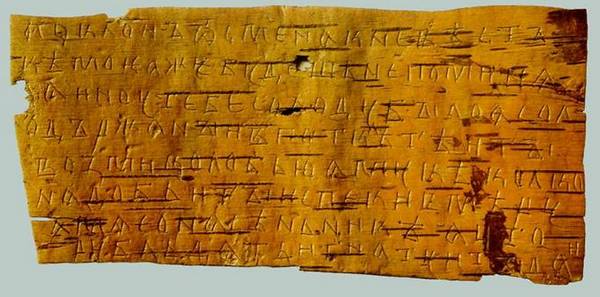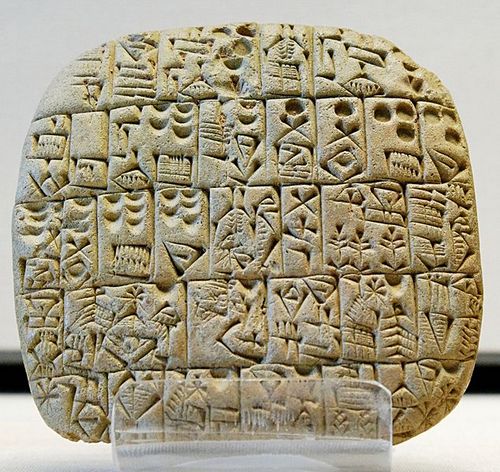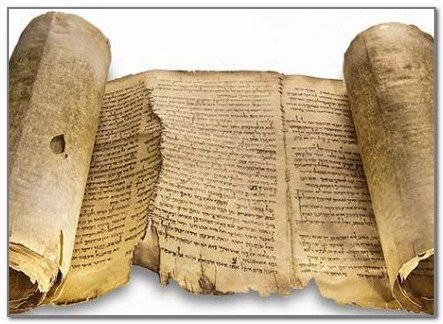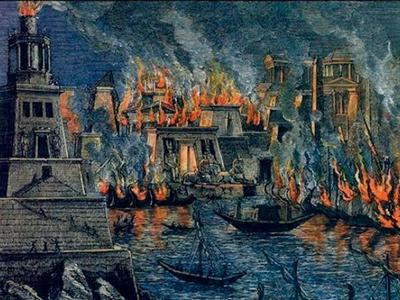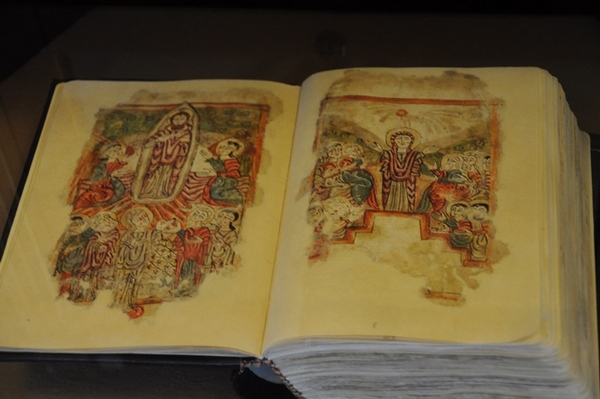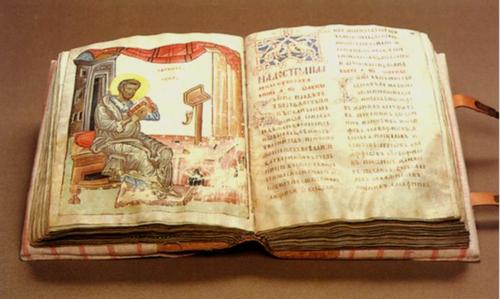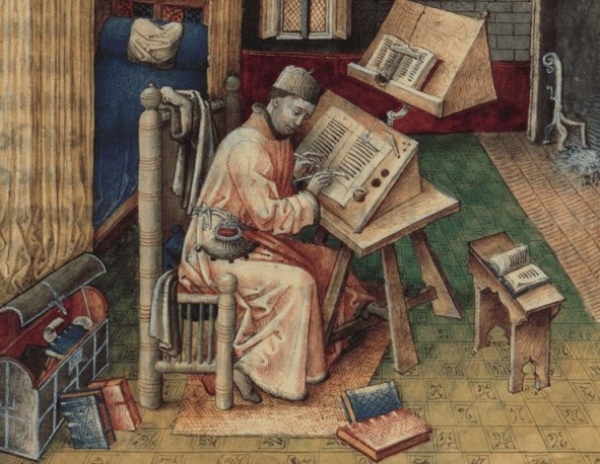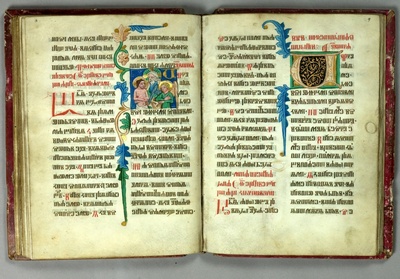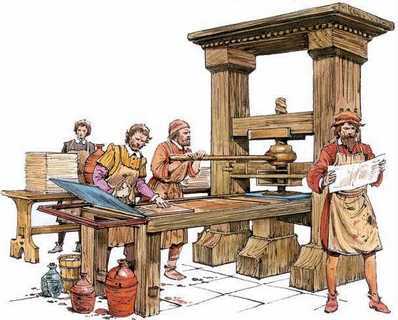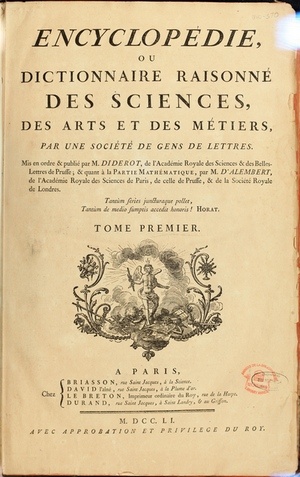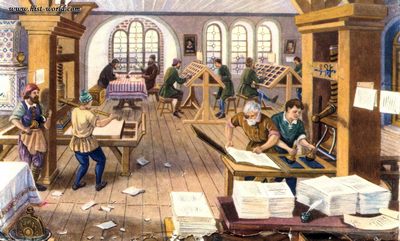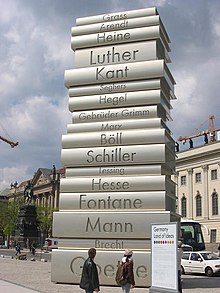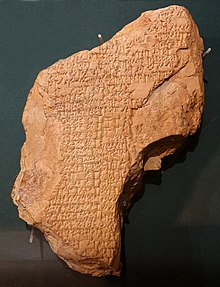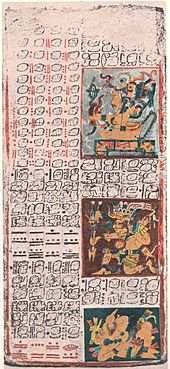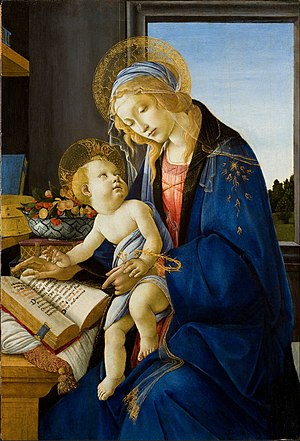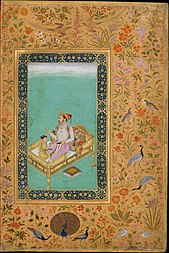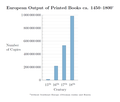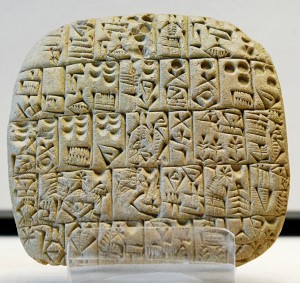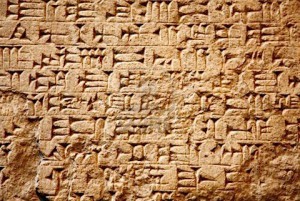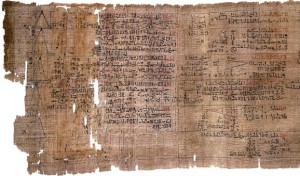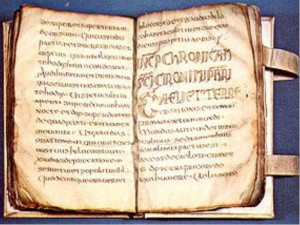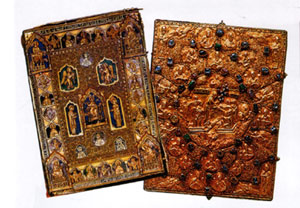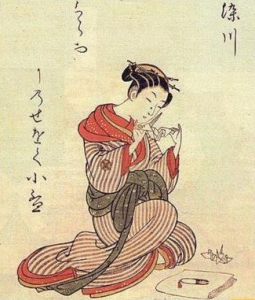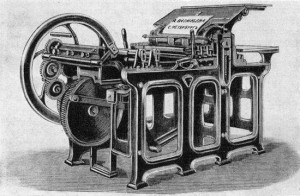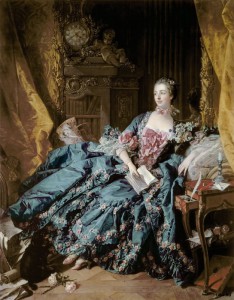Книги – корабли мысли, странствующие по волнам времени и бережно несущие свой драгоценный груз от поколения к поколению.
Фрэнсис Бэкон.
За период своей истории книги прошли длинный путь развития: от глиняных табличек Вавилона и Шумера, да египетских папирусов, через пергаментные книги средних веков и такие привычные нам книги из бумаги до современных электронных книг. Об истории книги, о том, как она развивалась, какими книгами пользовались наши далекие предки, обо всем этом, вы узнаете в этой статье.
О происхождении книг частично говорит само их название, латинское слово «liber» – книга, означает «лыко», то есть снятую с дерева кору, а английское «book» идет от названия дерева – бука, так как не севере Европы для письма использовались деревянные дощечки из древесной коры. Писали на них и в средневековом Новгороде, только новгородцы в отличие от англичан для письма использовали не кору бука, а березы, при раскопках старинного Новгорода археологами была найдена большая берестяная библиотека из различных письменных средневековых документов, составленных на березовой коре.
Так выглядит средневековая берестяная грамота.
Книги древнего мира
Но самые древние книги появились в первых развитых цивилизациях: Вавилоне, Шумере, древнем Египте, Ассирии. Оно и не удивительно, ведь книги необходимы для функционирования государственного аппарата, нужно вести государственные записи, родословные царей, архив царских указов, решений судов, бухгалтерские документы и многое другое. Все эти сугубо деловые документы и формировали первые книги. Но наряду с этими скучными деловыми записями творческое начало человека жаждало что-то еще, и вот в древнем Шумере появляется первая художественная книга в истории – «Эпос о Гильгамеше», рассказывающая нам о приключениях сказочного героя Гильгамеша.
Что же касается самих первых книг, то в Месопотамии они писались на глиняных табличках, а в древнем Египте, как на табличках, так и на папирусных свитках.
Месопотамская клинопись.
Впрочем, на папирусах писать было гораздо удобнее и быстрее, нежели выводить письмена на глиняных табличках и вскоре именно египетские папирусы стали ведущим материалом для создания древних книг. Книги из папируса того времени представляли собой большие папирусные свитки. Вот так они выглядели.
Интересный факт: папирус производился не только в Египте, но и многих других местах, а одним из крупнейших поставщиков папируса был финикийский город Библ, чье название стало ассоциироваться с книгами, именно отсюда идут такие слова как «Библия» и «библиотека».
К слову о библиотеках, многие просвещенные правители прошлого создавали великие библиотеки, где пытались собрать большинство книг того времени, одна из первых подобных библиотек – библиотека ассирийского царя Ашшурбанипала, найденная археологами, стала ценным источником исторических знаний о древнем мире. Так как в ней по приказу царя были собраны все ценные книги древнего Востока.
Но самой грандиозной была великая Александрийская библиотека, созданная по приказу египетского царя Птолемея. В момент своего расцвета она хранила более 800 тис. папирусных книг, практически в ней были собраны все письменные произведения античности и древнего востока: труды греческих философов и ученых, исторические хроники, египетские и вавилонские мифы, художественные романы и многое другое. К величайшему сожалению Александрийская библиотека была сожжена религиозными фанатиками, первый пожар устроили христиане, считающие библиотеку сосредоточием «богопротивных языческих свитков».
Пожар в Александрийской библиотеке.
Затем их дело довершили арабы-мусульмане, завоевавшие Египет в V веке, они успешно дожгли, то, что осталось после первого пожара. «Если в этих книгах написано не то, что в Коране, они вредны, а если то же самое – они бесполезны», – так по легенде заявил халиф Омар, отдавая приказ об окончательном уничтожении некогда великой библиотеки.
Но вернемся к папирусным свиткам, из древнего Египта они получили широкое распространение в античном мире. Ими активно пользовались древние греки, а позднее и римляне.
Именно в римскую эпоху огромную популярность приобретают художественные книги – романы. Ведь даже само слово «роман» переводится как «римский». Просвещенные римляне действительно любили читать, чтение у них считалось достойными и даже модным занятием, читали везде, в садах и парках, банях и даже на пирах. А так как длинные свитки при чтении разворачивать было не совсем удобно, находчивые римляне придумали их нарезать на отдельные листки и сшивать в аккуратные книжечки в кожаном переплете. Такие книги, названные «кодексами», обычно со стихами известных поэтов, знатные римские аристократы – патриции часто дарили друг другу. Именно римские книги-кодексы стали прообразом таких привычных для нас бумажных книг.
Книги в средние века
С падением Римской империи настали так званные «темные века», которые весьма плохо повлияли на книжное дело. Во-первых, на главную историческую сцену вместо просвещенных римлян и греков вышли безграмотные варвары, умеющие хорошо махать мечом и стрелять из лука, но совершенно не понимающих ценность произведений Цицерона, Витрувия или Аристотеля. А во-вторых, с падением Римской империи прекратились поставки папируса в Европу, этого главного книжного материала. Как результат на Европу раннего средневековья опустилась тотальная безграмотность, безграмотными были даже короли, не говоря уже о простолюдинах.
Единственными островками грамотности, науки, культуры, и, конечно же, книжного дела оставались христианские монастыри. Распространение христианства дало новый толчок книжному развитию, ведь в каждой церкви должно было быть Священное Писание – Библия, а также сборники молитв, которые монахи переписывали в массовом порядке. Так как при Богослужении книгой-свитком пользоваться было неудобно от слова совсем, то книги в переплете (книги-кодексы) с подачи христианских монахов окончательно вытеснили книги-свитки.
Что же касается отсутствия папируса в средневековой Европе, то ему нашли замену в виде другого материала – пергамента. Само его название происходит от города Пергам, где еще в ІІ веке до н. е. придумали делать записи на специально обработанной коже животных. Именно пергамент начали массово применять для создания книг в средневековье, он был более прочным, нежели папирус, на нем можно было писать с двух сторон, а в случае необходимости можно было стереть одну запись и поверх написать другую. Но был у пергамента и один существенный недостаток – он был очень дорогим.
Дороговизна пергамента обусловлена трудоемкостью его производства: делать пергамент приходилось не меньше 2 недель, на протяжении которых коровью, овечью или козью шкуру вымачивали в известняковом растворе, выбеливали мелом и шлифовали. Хороший пергамент был таким же гладким и белым как современная бумага, только более тяжелым. Чтобы книга из пергаментных листов не разлеталась, ее сшивали и заключали в специальный переплет из деревянных дощечек. В целом на одну книгу уходило 6-7 коровьих шкур.
Поэтому книги в средние века также были ужасно дорогими и даже состоятельные люди того времени не всегда могли себе позволить их приобретение.
Интересный факт: в средневековых церквях храмовая Библия всегда была прикована к алтарю стальными цепями, дабы ее не стащили воришки, так как именно Библия была самым дорогим в церкви, порой она была дороже самого церковного здания.
Средневековая книга из пергамента.
Монахи занимались переписыванием книг в специальных скрипториях, быть средневековым переписчиком, было не такой уж и простой задачей (мне набирать этот текст на клавиатуре компьютера в разы проще, нежели было средневековому монаху, который в очередной раз переписывал Библию или жития святых). Ведь писать приходилось в темное время при свечах, с помощью не совсем удобного гусиного пера, да еще и делать это каллиграфическим почерком.
«Этот труд тяжел. Он портит зрение, сгибает спину и заставляет болеть все тело. Как моряк, наконец возвращающийся в порт, писарь с нетерпением ждет момента, когда дойдет до последней строчки», – так жаловался неизвестный средневековый монах о своей работе.
Интересный факт: средневековые книги из пергамента были также очень тяжелыми и весили порой до 10 кг.
Первые книги из бумаги
Революцию в книжном деле принесло появление бумаги. Вернее бумагу изобрели еще в древнем Китае и китайцы долгое время пользовались этим своим полезнейшим изобретением, причем из бумаги они делали не только книги, но первыми ввели в обращение бумажные деньги, и использовали бумагу в качестве туалетной.
Однако европейцы впервые увидели бумагу лишь во время своих крестовых походов, у арабов, к которым она попала от китайских купцов. Крестоносцы были поражены расточительностью арабов по отношению к бумаге, те на ней не только писали, но и заворачивали в нее товары, что для европейцев, привыкших к супердорогому пергаменту, было, наверное, культурным шоком (это как если бы мы увидели человека, который кормит черной икрой своих собак).
Но вскоре европейцы поняли, что бумага не такая уж и дорогая и вскоре начали ее производство в Европе. Первые бумажные книги были в разы дешевле пергаментных, книги перестали стоить целые состояния и стали доступными дли широких слоев населения.
Изобретение книгопечатания
Затем в XV веке в книжном деле состоялась еще одна грандиозная революция, талантливый немецкий изобретатель Иоганн Гутенберг смастерил печатный станок, на котором была напечатана первая книга, разумеется, это была Библия. Так появилось книгопечатание.
Маленькое уточнение, на самом деле книгопечатание появилось еще задолго до Гутенберга, опять изобретательные китайцы тут были первыми, еще в Х веке они научились печатать книги, но есть одно но. Способ книгопечатания, изобретенный Гутенбергом, радикально отличался от китайского невероятным ускорением процесса печати. С неподвижных досок Китая можно было до бесконечности печатать один и тот же труд Лао-цзы или Конфуция. Для того же, чтобы отпечатать сборник стихов Ли-Бо или Цзюй-и, надо было вырезывать новые доски.
А Гутенберг с одним и тем же запасом подвижных букв, которые имелись в его печатном станке, мог печатать Библию, латинскую грамматику и календарь. Меньшая затрата труда и в разы большая продуктивность.
Книги в новое время
Книгопечатание утверждалось в Европе с большим трудом, против него то и дело восставали переписчики книг, боясь, что его распространение лишит их работы. Но все-таки прогресс было не остановить. В эпоху кризиса католической церкви, с началом реформации, печатные памфлеты против папы Римского разлетались как горячие пирожки. Огромной популярностью стали пользоваться и предсказания астрологов. А с ростом всеобщей грамотности, появлением школ и университетов появился и огромный спрос на книги, которые благодаря бумаге и книгопечатанию стали гораздо более дешевыми и доступными. Книжное дело, будто бы пережив спячку в средневековье, когда в ходу были одни лишь религиозные, церковные книги, возродилось с новой силой. Вновь пишутся и печатаются светские книги: и утопические романы и научные трактаты по медицине и астрономии и даже кулинарные книги.
Первые печатные книги, стародруки, выглядели во многом схоже со средневековыми пергаментными книгами, они были такими же массивными, тяжелыми, с вычурными готическими шрифтами. Изменение в этом деле начал итальянский издатель Альд Мануций, он первым заменил готический шрифт удобными для чтения буквами.
Примерно в это же время появляется первая книжная цензура, так католическая церковь активно борется с еретическими на ее взгляд трудами реформаторов: Лютера, Кальвина, Цвингли. Под запрет попадают и научные труды Николая Коперника, Галилео Галилея и многие другие книги более поздних авторов, например энциклопедия французских просветителей Даламбера и Дидро, которую, первое время выдавали подпольно.
Титульный лист этой энциклопедии.
Вскоре свободолюбивая Голландия становится одним из самых больших центров европейского книгопечатания, если в наши дни в Голландии можно легально покурить травку, то в XVII там можно было легально напечатать любую, даже самую еретическую книгу и не угодить при этом на костер.
Первые книжные издательства на заре своей истории выглядели практически так же, как и в наши дни. В них работали граверы иллюстраций, печатники, переплетчики, благодаря труду этих людей новая книга появлялась на свет. Сейчас некоторые книги, напечатанные знаменитыми книжными издательствами, (к примеру, первое издание «Дон Кихота» Мигеля Сервантеса), стоят сотни тысяч долларов, некоторые редкие книги могут оцениваться в миллионы долларов, а некоторое (как например Библия Гутенберга, первая напечатанная Библия) и вовсе бесценны.
Так прошло еще несколько веков, и вот в XІX веке рождается массовая литература, которая стоит на трех китах: детективах, дамских романах и фантастике. Книги теперь покупаются и читаются не только лишь для самообразования, но и для развлечения, досуга, появляются первые книжные бестселлеры, например в Англии такими стали «приключение Шерлока Холмса» Артура Конана Дойля, в конце XІX, начале ХХ века эта книга пользовалась бешеной популярностью. Также как примерно в конце ХХ века необычно популярными стали книги о «Гарри Поттере» Джоан Роулинг.
И говоря о книгах нашего времени, то с одной стороны любовь к книгам сейчас вытесняется телевизором, компьютером, ведь проще посмотреть какой-то фильм, поиграть в компьютерную игру, нежели почитать книгу. А с другой стороны умные и образованные люди, стремящиеся к познанию, всегда будут читать, и им есть, где развернутся в современную компьютерную эру. Ведь книги получают новое развитие, появляются электронные книги, к тому же с развитием интернета можно легко получить доступ к самым разным книгам, даже не выходя из дома, и это здорово.
Автор: Павел Чайка, главный редактор исторического сайта Путешествия во времени
При написании статьи старался сделать ее максимально интересной, полезной и качественной. Буду благодарен за любую обратную связь и конструктивную критику в виде комментариев к статье. Также Ваше пожелание/вопрос/предложение можете написать на мою почту pavelchaika1983@gmail.com или в Фейсбук, с уважением автор.
Самые древние книги в истории
Автор:
25 апреля 2016 10:30
Этим книгам несколько тысяч лет. Они бесценны как для культуры и истории, так для нас, простых читателей.
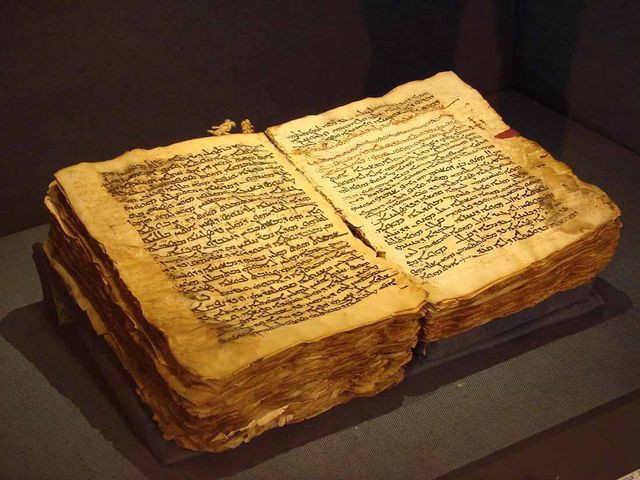
Сказание о Гильгамеше
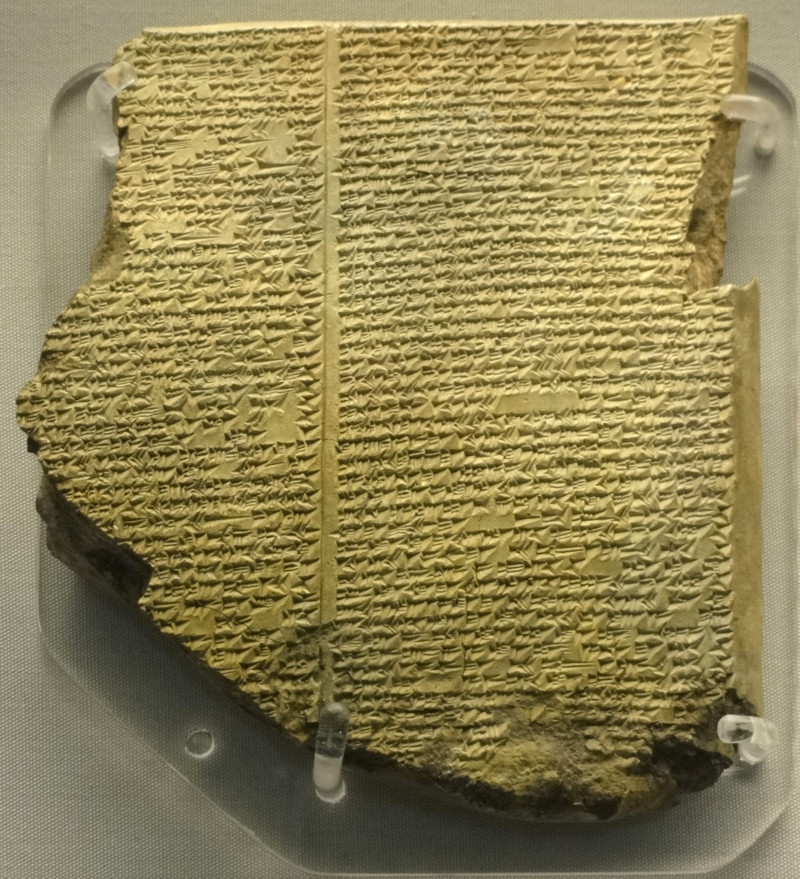
Наиболее полная версия поэмы о Гильгамеше была найдена в середине XIX века при раскопках библиотеки ассирийского царя Ашшурбанипала в древней Ниневии. Раскопки проводил английский археолог Остин Генри Лэйярд. Эпос был записан клинописью на 12 глиняных шестиколонных дощечках на аккадском языке и включал в себя около 3000 стихов. Ученые датируют эпос VIII — VII веками до н. э. Таблички с текстом эпоса хранятся в Британском музее, куда их в 1852 году передал ассистент археолога Ормузд Расам. Благодаря сказанию, мы имеем представление о религии древних людей и об их философии. Главными героями эпоса стали полубог Гильгамеш, царь Урука и человек из глины Энкиду. Большая популярность эпоса у современных читателей объясняется рассказом о Всемирном потопе, который включен в него.
Книга мёртвых
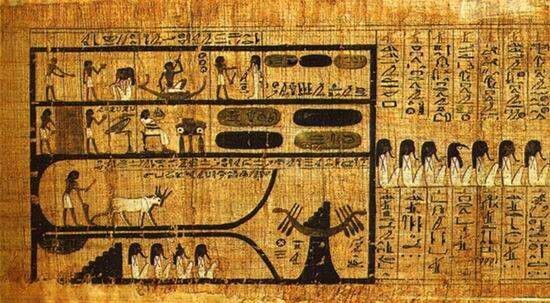
Этот мистический сборник древнеегипетских текстов включает в себя молитвы, песнопения и заклинания, которые должны были облегчить умершему загробную участь. Название «Книга мертвых» придумал египтолог Карл Лепсиус, хотя у сборника существует и более точное название: «Главы о выходе к свету дня». Создавалась она с VI по I век до н. э. Больше всего текстов найдено в захоронениях города Фивы, где они были написаны на папирусах и украшены превосходными рисунками, изображающими сцены погребения мёртвого и загробного суда. Самые значимые папирусы хранятся в Британском музее.
Синайский кодекс
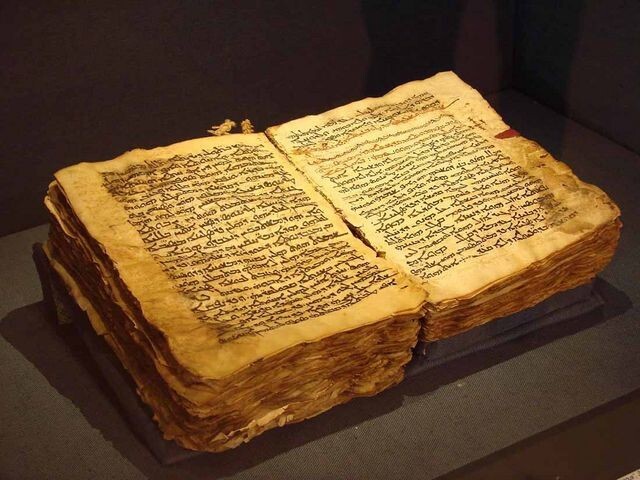
Самая древняя книга привычного нам формата — Синайский кодекс датируется IV веком н. э. Первые 43 страницы кодекса были найдены немецким ученым Константином Тишендорфом в 1844 году в библиотеке монастыря Святой Елены на Синайском полуострове. Ученый нашел их в куче макулатуры, приготовленной для уничтожения. Еще 86 страниц он нашел в результате целенаправленных поисков. Тишендорф увез их в Европу и обнародовал. Он хотел вернуться в монастырь, чтобы вывезти остальное, но монахи даже не дали ему взглянуть на страницы. Положение было спасено Российским императором Александром II, который заплатил 9 тысяч рублей, после чего Тишендорф вывез страницы в Россию. На тончайшем белом пергаменте на греческом языке был записан неполный текст Ветхого Завета, полный – Нового Завета и два произведения реннехристианских авторов: «Послание Варнавы» и «Пастырь» Гермы. До 1933 года Синайский кодекс хранился в Императорской национальной библиотеке в России, но большевики решили избавиться нее и «уступили» Британскому музею. Сейчас у 347 страниц этой книги четыре владельца: Национальная российская библиотека, Британский музей, университет Лейпцига и монастырь Святой Елены.
Евангелия Гаримы
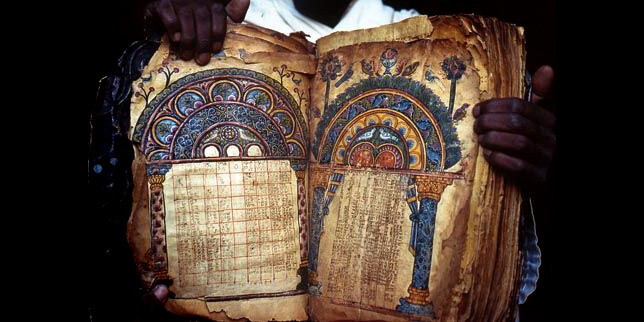
Два Евангелия Гаримы хранятся в Эфиопии, в монастыре святого Гаримы, который расположен недалеко от города Адуа. Созданы в период с 330 года по 650 год. Согласно преданию, святой Гарима переписал их по обету за один день. Евангелия написаны на священном письменном языке древней Абиссинии геэз. Евангелия в 1950 году нашла специалист по истории искусств из Великобритании Беатрис Плэйн. Но книги попали к варвару-переплетчику, который вплел в одно из них страницы XV века. И только в 2006 году ученые смогли вернуть книги в первоначальное состояние и датировать их. К сожалению, реставрировать книги не удалось, и они остались в монастыре. Евангелия оформлены в одной манере, но переписаны разными почерками. В первой книге 348 страниц и 11 иллюстраций, переплет сделан из досок, покрытых золоченой медью. Вторая книга содержит 322 страницы, 17 миниатюр, в том числе портреты четырех евангелистов. Переплет выполнен из серебра. Ученые выяснили, что художник и переписчик работали одновременно, и иллюстрации сделаны африканскими художниками.
Алмазная сутра
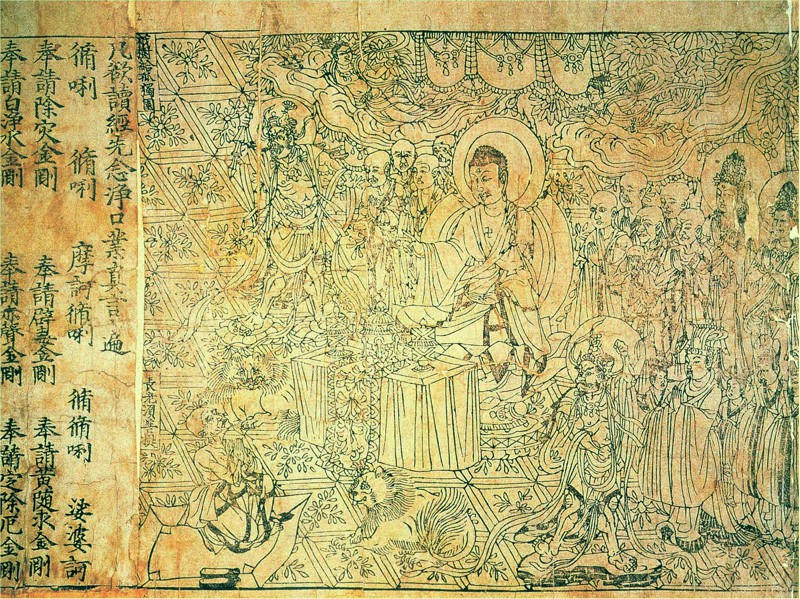
Алмазная сутра, вторая в мире печатная книга, содержащая основополагающий текст буддизма, была напечатана методом ксилографии – оттиска гравюр. Книга представляет собой свиток из шести листов текста и одной гравюры, на которой изображен Будда. Свиток длиной почти в пять метров нашел археолог Марк Стейн в пещере Магао недалеко от города Даньхуаня на западе Китая в 1900 году. Он выкупил свиток у даосского монаха Вань Юаньлу и увез в Великобританию. Книга была отпечатана человеком по имени Ван Цзи по поручению его родителей в 15-ом числе 4-ой луны года Сяньтун, то есть 11 мая 868 года. Хранится в Британской библиотеке.
Тора
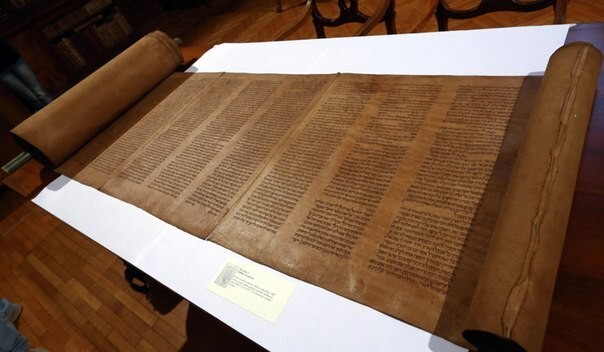
В 2013 году в университетской библиотеке Болоньи в Италии была найдена самая древняя рукопись Торы. Она представляет собой 36-метровый свиток из мягкой овечьей кожи. О книге ничего не знали из-за ошибки в определении возраста книги, которая произошла в 1889 году. Тогда библиотекарь датировал книгу XVII веком. Ошибку обнаружил преподаватель университета Мауро Перани. Он осмотрел манускрипт и увидел, что стиль повествования относится к традиции древнего Вавилона, а значит, пергамент может быть старше. Кроме этого, в тексте были детали, которые были запрещены к воспроизведению с XII века. Возраст Торы определялся с помощью радиоуглеродного анализа дважды: в Италии и в США. Стало понятно, что Тора написана больше 850 лет назад.
Остромирово Евангелие
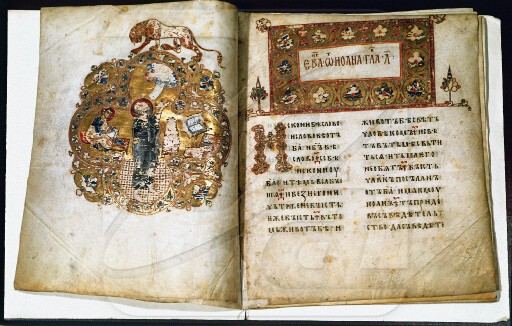
Древнейшая точно датированная книга Руси. Хранится в Российской национальной библиотеке (Санкт-Петербург). Написана в 1056-1057 годах дьяконом Григорием для новгородского посадника Остромира, родственника князя Изяслава Ярославовича. Книга уникальна там, что после канонического текста дьякон подробно написал об обстоятельствах ее изготовления и указал дату от сотворения мира. Евангелие было найдено среди имущества Воскресенской церкви Верхоспасского собора в 1701 году. По приказу Петра I была отослана в Петербург. Повторно обнаружена в покоях императрицы Екатерины после ее кончины и преподнесена Александру I. Император передал Евангелие в Императорскую публичную библиотеку. Именно благодаря Остромирову Евангелию, были созданы современные словари и грамматики старославянского языка.
Источник:
Еще крутые истории!
Новости партнёров
реклама

Второй наш «нескучный» урок «Из глубины веков»
посвящен очень интересной теме: мы совершим увлекательное путешествие в
ИСТОРИЮ КНИГИ И КНИГОПЕЧАТАНИЯ.

А было время, когда на нашей земле не было книг. Чтобы что-то запомнить, люди делали зарубки на деревьях, на стенах пещер, завязывали узелки на веревке – это и были первые книжки. Люди научились писать шесть тысяч лет тому назад. А бумагу стали делать только через четыре тысячи лет после этого. Какой же материал использовали для письма раньше?
КАМЕНЬ
Самые древние письма, дошедшие до нас, написаны на камне. Первобытные люди жили в каменных пещерах. Письменности не было, но люди умели рисовать. А в рисунках старались отразить главные события своей жизни: возделывание поля, военные походы, охоту… Ученые нашли много пещер, стены которых покрыты рисунками: там были изображены мамонты, олени, буйволы и сами первобытные охотники с копьями, стрелами, каменными топорами. Такие же рисунки ученые находили и на скалах. Историю великих государств – Ассирии и Вавилонии – нам поведали каменные столбы, испещренные письменными знаками. Врезанные в камень строки – самое долговечное письмо.
Самой большой книгой в мире считается древнейшая летопись, высеченная на стенах храма в Фивах в Греции. Каменные страницы этой летописи достигают 40 метров в ширину.
ГЛИНА



Ученые поняли, что попали в библиотеку. Библиотека была царская. На табличках было записано, сколько зерна собрано, сколько золота привезли из военного похода, сколько захвачено пленных, которые станут рабами. На глиняных табличках писались также медицинские рецепты.
ПАПИРУС


В библиотеке Британского музея хранится редкая книга-свиток – папирус Гарриса, названный так в честь своего открывателя. В нем сорок с лишним метров.

ПЕРГАМЕНТ

И вот в Пергаме придумали новый материал для письма, который назвали пергаментом – по имени государства, где он был придуман. Этим материалом была кожа. Пергамент был очень прочен. Одна беда – дорог: для изготовления одной книги нужно было целое стадо животных.
Овечью или козлиную шкуру освобождали от шерсти, вымачивали и долго скоблили, чтобы она стала тонкой. После просушки получался прочный, легкий материал, на котором было удобно писать, а потом сворачивать в свитки, которые могли храниться очень долго. Писали на пергаменте тростниковой палочкой или птичьим пером, заостренным и расщепленным.
Пергамент стали разрезать на страницы, сшивать их и переплетать в прочный деревянный или кожаный переплет. Эти древние книги писались и рисовались искусными писцами и художниками, и каждая такая книга была настоящим произведением искусства.
БЕРЕСТА

Простой же народ писал на бересте – это кора березы, подвергнутая специальной обработке. Буквы наносили костяной или железной палочкой – писалом. Назывались такие «книги» берестяными грамотами.
БУМАГА

Почти 400 лет скрывали китайцы от всего мира секрет изготовления бумаги. Но нет таких секретов, которые бы люди не смогли раскрыть. Прошло время – и способ изготовления бумаги стал известен всей Азии, а затем и Европе. Бумагу научились делать из старых тряпок. Их расщепляли на волокна, долго варили, добавляли склеивающие вещества, а потом выливали на сетки, сплетенные из конского волоса или тончайшей медной проволоки.
Бумага оказалась самым удобным материалом для письма. На ней отлично писалось кисточкой или расщепленным гусиным пером. Изготавливать бумагу было просто и дешево.
Деревянные чурбаки (брусья бруски) размалывают в мелкие щепки, подолгу варят в огромных котлах, добавляют к ним нужные вещества, а затем эта жидкость попадает в бумагоделательную машину. Белая масса проливается на движущуюся тонкую сетку, потом прессуется и сушится между горячими барабанами. Затем готовые листы бумаги попадают в механизмы, делающие бумагу гладкой и белой.
Специальные переписчики, часто монахи, вручную писали каждую страницу книги, украшая ее небольшими рисунками (миниатюрами) и художественно выполненными заглавными буквами. Чтобы создать такую книгу требовались неимоверные усилия и много времени… А между тем потребность в книгах росла с каждым годом… Необходимо было как-нибудь упростить и ускорить процесс выпуска книг. Мастера стали вырезать рисунки на металлической, а позже на деревянной пластинке. Ее покрывали краской, а затем, прижимая к бумаге, получали оттиск рисунка. Первопечатные книги (инкунабулы) сохранились в небольшом количестве.. Попыток совершенствования книг было очень много, но настоящую революцию в книгопечатании произвел житель немецкого города Майнца Иоганн Гуттенберг.


Человеческая мысль не стоит на месте. Наверное, придумают другой материал, который будет еще удобнее, еще дешевле, еще проще в обращении.
Проверь свои знания!
1. Как называлось письмо в виде рисунков?
- пиктография;
- клинопись;
- иллюстрация.
2. Из одного древнего рецепта: «Обрывки шелка, тряпки, отслужившие рыболовные сети, древесная кора…». Что должно получиться из этих компонентов?
- бумага;
- папирус;
- пергамент.
3. Изображение слов с помощью знаков в виде клинышков – это…
- идеография;
- пиктография;
- клинопись.
4. Материал для письма, изготовленный из кожи овцы или теленка, называется…
- береста;
- пергамент;
- папирус.
5. В какой стране была изобретена бумага?
- в Германии;
- в Греции;
- в Китае.
6. Первой книгой, отпечатанной типографским способом, была…
- Азбука;
- часослов;
- Библия.
Прочти ЭТИ КНИГИ – они помогут тебе узнать много интересного об истории книги и книгопечатания
Анушкин А. Тайны старопечатной книги / А. Анушкин. – Симферополь : Таврия, 1972. – 128 с.
Дацкевич В. Как делают книгу : фотокнижка / В. Дацкевич. – М. : Дет. лит., 1987. – 24 с.
Драчук В. Дорогами тисячоліть : про що розповідали письмена : нариси / В. Драчук. – К. : Веселка, 1978. – 254 с. : ил.
Дьяченко Н. Рождение книги : кн. для учащихся ст. кл. сред. шк. – М. : Просвещение, 1990. – 111 с. : ил. – (О профессиях, производстве и людях труда).
Зубков Б. Книжка про книжку / Б. Зубков. – М. : Малыш, 1984. – 28 с.
Коваленко Л. Приключение книжки : повесть-сказка / Л. Коваленко. – Днепропетровск : Промінь, 1977. – 61 с.
Лурье С. Письмо греческого мальчика : ист. рассказ / С. Лурье. – М. : Дет. лит., 1978. – 47 с. – (Маленькая историческая библиотека).
Львов С. Книга о книге : для учащихся ст. кл. / С. Львов. – М. : Просвещение, 1980. – 206 с. : ил.
Мальков Б. Волшебники книжного города : повесть о тех, кто делает книги / Б. Мальков. – М. : Дет. лит., 1979. – 111 с. – (Герои нашего времени).
Осетров Е. Сказ о Друкаре Иване и его книгах / Е. Осетров. – М. : Малыш, 1983. – 95 с. : ил.
Перехвальская Е. Откуда азбука пошла / Е. Перехвальская. – М. : Малыш, 1989. – 26 с.
Разгон Л. Чёрным по белому / Л. Разгон. – М. : Малыш, 1982. – 30 с. – (Почемучкины книжки).
Розум Ю. Здесь рождается книга / Ю. Розум, И. Ковка. – К. : Техніка, 1984. – 70 c. – (Твоя будущая профессия).

Мир изменился с появлением печатной книги. Однако одной вещью, которая существенно не изменилась, была форма самой книги, древняя форма кодекса оставалась практически нетронутой. Что быстро менялось, так это способ производства и распространения книг. Проще говоря, механическое воспроизведение книг означало большую их доступность по более низкой цене. А рост международной торговли позволил книгам иметь более широкий охват.
Стремление к знаниям среди растущего среднего класса и новая доступность классических текстов способствовали Ренессансу и позволили широко распространять политические, интеллектуальные, религиозные и культурные идеи. Также впервые многие люди могли читать одни и те же книги и одновременно подвергаться воздействию одних и тех же идей, что привело к появлению средств массовой информации и массовой культуры. Изменилась и наука, появилась возможность познакомиться с теориями и открытиями других ученых. Технологические и интеллектуальные идеи распространялись быстрее, что позволило ученым опираться на прорывы и успехи коллег.
По мере развития Ренессанса численность среднего класса росла, как и уровень грамотности. Вместо нескольких сотен драгоценных томов, хранящихся в монастырских или университетских библиотеках, книги были доступны людям вне этих учреждений. Массовое производство книг помогло демократизации знаний. Всего за несколько сотен лет многие люди получили доступ к материалам для чтения, и книги больше не считались священными объектами. Однако не обошлось и без сопротивления. Отчасти благодаря распространению книг Римская католическая церковь перестала быть доминирующим учреждением средневековой Европы. Поэтому церковь долгое время была против массового распространения книг и пыталась контролировать выпуск новых изданий. Уже в 1517 году Мартин Лютер спровоцировал протестантскую реформацию. Он бросил вызов авторитету церкви, настаивая на том, что люди имеют право читать Библию на своем родном языке.
Поскольку книги стали более доступными, люди захотели читать произведения, написанные на их родном языке. Божественная комедия Данте (впервые напечатанная на итальянском языке в 1472 г.) и Кентерберийские рассказы Чосера (изданные на среднеанглийском языке в XV веке) считаются одними из наиболее ранних и известных книг на национальном языке. В этот период стали расцветать библиотеки. Как и в древнем Египте, библиотеки вновь стали средством демонстрации национальной мощи и богатства. К концу XV века, типографии распространились по всей Европе. Изобретение Гутенберга имело ошеломительный успех, печать и продажа книг быстро росли. До изобретения печатного станка общее количество книг во всей Европе составляло около 30 000. К 1500 году число книг в Европе выросло до 10–12 миллионов.
Сегодня современные издатели используют невероятные технологические достижения для очень быстрого производства книг разных размеров и форм. Хотя существует много видов машин для печати, большинство из них работают по стандартным этапам. Принтеры печатают текст книги на больших листах бумаги, иногда размером со страницу газеты. Работа с большими объемами бумаги позволяет принтерам снизить затраты. Большие листы нарезаются на меньшие, которые по-прежнему примерно в два раза больше готовой книги. Затем эти листы складываются пополам и сшиваются вместе. Наконец, сложенные и сшитые страницы обрезаются до их окончательного размера и приклеиваются к корешку обложки книги. В зависимости от качества книги могут быть добавлены дополнительные штрихи, такие как пустые страницы в передней и задней части книги или специальная лента по краям обложки для увеличения срока службы.
The history of books became an acknowledged academic discipline in the 1980s. Contributors to the discipline include specialists from the fields of textual scholarship, codicology, bibliography, philology, palaeography, art history, social history and cultural history. Its key purpose is to demonstrate that the book as an object, not just the text contained within it, is a conduit of interaction between readers and words.
Prior to the evolution of the printing press, made famous by the Gutenberg Bible, each text was a unique handcrafted valuable article, personalized through the design features incorporated by the scribe, owner, bookbinder, and illustrator.[1] Analysis of each component part of the book reveals its purpose, where and how it was kept, who read it, ideological and religious beliefs of the period and whether readers interacted with the text within. Even a lack of evidence of this nature leaves valuable clues about the nature of that particular book.
Origins[edit]
The history of the book became an acknowledged academic discipline in the latter half of the 20th century. It was fostered by William Ivins Jr.’s Prints and Visual Communication (1953) and Henri-Jean Martin and Lucien Febvre’s L’apparition du livre (The Coming of the Book: The Impact of Printing, 1450–1800) in 1958 as well as Marshall McLuhan’s Gutenberg Galaxy: The Making of Typographic Man (1962). Another notable pioneer in the History of the Book is Robert Darnton.[2]
Chronology[edit]
The history of the book starts with the development of writing, and various other inventions such as paper and printing, and continues through to the modern-day business of book printing. The earliest knowledge society has on the history of books actually predates what would conventionally be called «books» today and begins with tablets, scrolls, and sheets of papyrus. (The current format that we consider to be books, with separate sheets fastened together rather than a scroll, is called a codex (plural codices)). Then hand-bound, expensive, and elaborate manuscripts appeared in codex form. These gave way to press-printed volumes and eventually led to the mass-printed volumes prevalent today. Contemporary books may even have no physical presence with the advent of the e-book. The book also became more accessible to the disabled with the advent of Braille and audiobook.
Clay tablets[edit]
Clay tablets were used in Mesopotamia in the 3rd millennium BCE. The calamus, an instrument with a triangular point, was used to inscribe characters in moist clay. Fire was used to dry the tablets out. At Nineveh, over 20,000 tablets have been found, dating from the 7th century BCE; this was the archive and library of the kings of Assyria, who had workshops of copyists and conservationists at their disposal. This presupposes a degree of organization of books, consideration given to conservation, classification, etc. Such tablets continued to be used until the 19th century in various parts of the world, including Germany, Chile, Philippines, and the Sahara Desert.[4][5]
Cuneiform and Sumerian writing[edit]
Writing originated as a form of record-keeping in Sumer during the fourth millennium BCE[6][7] with the advent of cuneiform. Many clay tablets have been found that show cuneiform writing used to record legal contracts, create lists of assets, and eventually record Sumerian literature and myths. Archaeologists have found scribal schools from as early as the second millennium BCE, where students were taught the art of writing. Developed in what is now Iraq,[8] «cuneiform» script was later named after the Latin word cuneus, meaning wedge-shaped.[9][7] Scribes often wrote cuneiform on clay, but sometimes they used precious materials such as gold.[7] Cuneiform was written in different languages, such as Sumerian, Akkadian, and Greek, for more than three thousand years, ending only when the Sassanian Empire conquered Babylon and forced the scribes to stop writing.[9][10] Some of the surviving cuneiform tablets were written by student scribes.[7]
Papyrus[edit]
After extracting the marrow from the stems of Papyrus reed, a series of steps (humidification, pressing, drying, gluing, and cutting) produced media of variable quality, the best being used for sacred writing.[11] In Ancient Egypt, papyrus was used as a medium for writing surfaces, maybe as early as the First Dynasty, but first evidence is from the account books of King Neferirkare Kakai of the Fifth Dynasty (about 2400 BCE).[12] A calamus, the stem of a reed sharpened to a point, or bird feathers were used for writing. The script of Egyptian scribes was called hieratic, or sacerdotal writing; it is not hieroglyphic, but a simplified form more adapted to manuscript writing (hieroglyphs usually being engraved or painted). Egyptians exported papyrus to other Mediterranean civilizations including Greece and Rome where it was used until parchment was developed.[13]
Papyrus books were in the form of a scroll of several sheets pasted together, for a total length of 10 meters or more. Some books, such as the history of the reign of Ramses III, were over 40 meters long. Books rolled out horizontally; the text occupied one side and was divided into columns. The title was indicated by a label attached to the cylinder containing the book. Many papyrus texts come from tombs, where prayers and sacred texts were deposited (such as the Book of the Dead, from the early 2nd millennium BCE).
Papyrus was a common substrate to be used as notarial documents, tax registries, legal contracts, etc.[14] Scrolls were typically held vertically to be read and text was written in long columns. Literary texts, on the other hand, were traditionally transcribed into the codex form.[14] After the latter half of the 10th century CE, leftover papyrus in Egypt was often used by bookbinders for making book covers since paper had replaced papyrus as the dominant substrate for books.[14]
East Asia[edit]
China[edit]
Before the introduction of books, writing on bone, shells, wood and silk was prevalent in China long before the 2nd century BCE, until paper was invented in China around the 1st century CE. China’s first recognizable books called jiance or jiandu, were made of rolls of thin split and dried bamboo bound together with hemp, silk, or leather.[15] The discovery of the process using the bark of the mulberry to create paper is attributed to Cai Lun, but it may be older.[16] Texts were reproduced by woodblock printing; the diffusion of Buddhist texts was a main impetus to large-scale production. The format of the book evolved with intermediate stages of scrolls folded concertina-style, scrolls bound at one edge («butterfly books»), and so on.
Although there is no exact date known, between 618 and 907 CE —the period of the Tang Dynasty— the first printing of books started in China.[17][18] The oldest extant printed book is a work of the Diamond Sutra and dates back to 868 CE, during the Tang Dynasty.[17] The Diamond Sutra was printed by method of woodblock printing, a strenuous method in which the text to be printed would be carved into a woodblock’s surface, essentially to be used to stamp the words onto the writing surface medium.[19] Woodblock printing was a common process for the reproduction of already handwritten texts during the earliest stages of book printing. This process was incredibly time-consuming.[20]
Because of the meticulous and time-consuming process that woodblock printing was, Bi Sheng, a key contributor to the history of printing, invented the process of Movable type printing (1041–1048 CE).[20][21] Bi Sheng developed a printing process in which written text could be copied with the use of formed character types, the earliest types being made of ceramic or clay material.[20][21] The method of movable type printing would later be independently invented and improved by Johannes Gutenberg.[22]
Japan[edit]
A lot of extremely detailed text was produced in early 17th century Japan. For instance, Hitomi Hitsudai spent sixty years taking field notes on 499 types of edible flowers and animals for his book Honchō shokkan (The Culinary Mirror of the Realm).[23] This detailed style of writing was common in the early years when the majority of literate people were of higher classes. Soon afterwards, literacy increased, as hundreds (some say thousands) of schools taught children the vocabulary of geography, history, and individual crafts and callings.[24] The highly detailed style still persisted as it was consistent in many gazetteers, emerging as a social lexicon. In some instances, family almanacs and encyclopedias were put together regionally.[23]
While the highly detailed writing form persisted, a simpler reading style also developed around the 1670s that was written for a popular readership. It used a simpler vernacular language, and was written almost directly for first-time book buyers. These original tales of fiction were popular among common samurai as well as common townspeople. Works went beyond fiction and also depicted certain crafts and manuals specialized for that topic.[23] These more popularized books were written in a newly emerging form of script[clarification needed]. Authors had to deal with the idea of the «reading public» for the first time. These authors took into account the different social strata of their audience and had to learn «the common forms of reference that made the words and images of a text intelligible» to the layman.[23]
Authors had reached a new market with their more simplistic writing. After passing this hurdle, they began writing about more than specified crafts and social lexicons. For the first time, writers had the chance to make once private knowledge public, and moved into more regional information guides.[23] Detail-oriented writing still persisted as writing became understood as something that needed to show «quantitative evidence in order to measure continuity against change».[25] The increasing literacy across Japan as well as the proliferation of authors made writing a semi-autonomous system.[clarification needed] However, there were still instances of censorship in the late 17th century. Despite the vast depiction of landscape, governmental powers ensured areas that entailed sensitive subjects, such as military households, foreign affairs, Christianity, and other heterodox beliefs, and disturbing current events were kept out of public works. This self-censorship did have drawbacks, as social commentary stayed in the higher social caste where this information was more readily available.[23] Despite these censors, public readings increased across Japan and created new markets that could be shared between the higher elites as well as middlebrow people, albeit with differing subject matter.
Pre-columbian codices of the Americas[edit]
In Mesoamerica, information was recorded on long strips of paper, agave fibers, or animal hides, which were then folded and protected by wooden covers. These were thought to have existed since the time of the Classical Period between the 3rd and 8th centuries, CE. Many of these codices were thought to contain astrological information, religious calendars, knowledge about the gods, genealogies of the rulers, cartographic information, and tribute collection. Many of these codices were stored in temples but were ultimately destroyed by the Spanish explorers.[26]
Currently, the only completely deciphered pre-Columbian writing system is the Maya script. The Maya, along with several other cultures in Mesoamerica, constructed concertina-style books written on Amate paper. Nearly all Mayan texts were destroyed by the Spanish during colonization on cultural and religious grounds. One of the few surviving examples is the Dresden Codex.[27]
Although only the Maya have been shown to have a writing system capable of conveying any concept that can be conveyed via speech (at about the same level as the modern Japanese writing system), other Mesoamerican cultures had more rudimentary ideographical writing systems which were contained in similar concertina-style books, one such example being the Aztec codices.
Florentine Codex[edit]
There are more than 2,000 illustrations drawn by native artists that represent this era. Bernardino de Sahagun tells the story of the Aztec people’s lives and their natural history. The Florentine Codex speaks about the culture religious cosmology and ritual practices, society, economics, and natural history of the Aztec people. The manuscript is arranged in both Nahuatl and in Spanish. The English translation of the complete Nahuatl text of all twelve volumes of the Florentine Codex took ten years. Arthur J.O. Anderson and Charles Dibble had a decade of long work but made it an important contribution to Mesoamerican ethnohistory. Years later, in 1979, the Mexican government published a full-color volume of the Florentine Codex. Now, since 2012, it is available digitally and fully accessible to those interested in Mexican and Aztec History.
The Florentine Codex is a 16th-century ethnographic research study brought about by the Spanish Franciscan friar Bernardino de Sahagun. The codex itself was actually named La Historia Universal de las Cosas de Nueva España.[28] Bernardino de Sahagun worked on this project from 1545 up until his death in 1590. The Florentine Codex consists of twelve books. It is 2500 pages long but divided into twelve books by categories such as; The Gods, Ceremonies, Omens, and other cultural aspects of Aztec people.
Wax tablets[edit]
Woman holding wax tablets in the form of the codex. Wall painting from Pompeii, before 79 CE.
Romans used wax-coated wooden tablets or pugillares upon which they could write and erase by using a stylus. One end of the stylus was pointed, and the other was spherical. Usually, these tablets were used for everyday purposes (accounting, notes) and for teaching writing to children, according to the methods discussed by Quintilian in his Institutio Oratoria X Chapter 3. Several of these tablets could be assembled in a form similar to a codex. Also, the etymology of the word codex (block of wood) suggests that it may have developed from wooden wax tablets.[29]
Parchment[edit]
Parchment progressively replaced papyrus. Legend attributes its invention to Eumenes II, the king of Pergamon, from which comes the name «pergamineum,» which became «parchment.» Its production began around the 3rd century BCE. Made using the skins of animals (sheep, cattle, donkey, antelope, etc.), parchment proved to be easier to conserve over time; it was more solid and allowed one to erase text. It was a very expensive medium because of the rarity of the material and the time required to produce a document. Vellum, in particular, is a fine quality parchment, made from calf hide.
Greece and Rome[edit]
The scroll of papyrus is called «volumen» in Latin, a word which signifies «circular movement,» «roll,» «spiral,» «whirlpool,» «revolution» (similar, perhaps, to the modern English interpretation of «swirl») and finally «a roll of writing paper, a rolled manuscript, or a book.»
In the 7th century Isidore of Seville explains the relation between codex, book, and scroll in his Etymologiae (VI.13) as this:
A codex is composed of many books (librorum); a book is of one scroll (voluminis). It is called codex by way of metaphor from the trunks (caudex) of trees or vines, as if it were a wooden stock, because it contains in itself a multitude of books, as it were of branches.
Description[edit]
The scroll is rolled around two vertical wooden axes. This design allows only sequential usage; one is obliged to read the text in the order in which it is written, and it is impossible to place a marker in order to directly access a precise point in the text. It is comparable to modern video cassettes. Moreover, the reader must use both hands to hold on to the vertical wooden rolls and therefore cannot read and write at the same time. The only volumen in common usage today is the Jewish Torah.
Book culture[edit]
The authors of antiquity had no rights concerning their published works; there were neither authors’ nor publishing rights. Anyone could have a text recopied, and even alter its contents. Scribes earned money and authors earned mostly glory unless a patron provided cash; a book made its author famous. This followed the traditional concept of the culture: an author stuck to several models, which he imitated and attempted to improve. The status of the author was not regarded as absolutely personal.
From a political and religious point of view, books were censored very early: the works of Protagoras were burned because he was a proponent of agnosticism and argued that one could not know whether or not the gods existed. Generally, cultural conflicts led to important periods of book destruction: in 303, the emperor Diocletian ordered the burning of Christian texts. Some Christians later burned libraries and especially heretical or non-canonical Christian texts. These practices are found throughout human history but have ended in many nations today. A few nations today still greatly censor and even burn books.
But there also exists a less visible but nonetheless effective form of censorship when books are reserved for the elite; the book was not originally a medium for expressive liberty. It may serve to confirm the values of a political system, as during the reign of the emperor Augustus, who skillfully surrounded himself with great authors. This is a good ancient example of the control of the media by political power. However, private and public censorship has continued into the modern era, albeit in various forms.
Proliferation and conservation of books in Greece[edit]
Little information concerning books in Ancient Greece survives. Several vases (6th and 5th centuries BCE) bear images of volumina. There was undoubtedly no extensive trade in books, but there existed several sites devoted to the sale of books.
The spread of books, and attention to their cataloging and conservation, as well as literary criticism developed during the Hellenistic period with the creation of large libraries in response to the desire for knowledge exemplified by Aristotle. These libraries were undoubtedly also built as demonstrations of political prestige:
- The Library at Antioch, a public library of which Euphorion of Chalcis was the director near the end of the 3rd century.
- The Library at Athens, the Ptolemaion, which gained importance following the destruction of the Library at Alexandria; the Library of Pantainos, around 100 CE; the library of Hadrian, in 132 CE.
- The Library at Pergamon, founded by Attalus I; it contained 200,000 volumes which were moved to the Serapeion by Mark Antony and Cleopatra, after the destruction of the Museion. The Serapion was partially destroyed in 391, and the last books disappeared in 641 CE following the Arab conquest.
- The Library at Rhodes, a library that rivaled the Library of Alexandria.
- The Library of Alexandria, a library created by Ptolemy Soter and set up by Demetrius Phalereus (Demetrius of Phaleron). It contained 500,900 volumes (in the Museion section) and 40,000 at the Serapis temple (Serapeion). All books in the luggage of visitors to Egypt were inspected and could be held for copying. The Museion was partially destroyed in 47 BCE.
The libraries had copyist workshops and the general organization of books allowed for the following:
- A catalog of books
- Conservation of an example of each text
- Literary criticisms in order to establish reference texts for the copy (example : The Iliad and The Odyssey)
- The copy itself, which allowed books to be disseminated
- Translation (the Septuagint Bible, for example)
Book production in Rome[edit]
Book production developed in Rome in the 1st century BC with Latin literature that had been influenced by the Greek. Conservative estimates place the number of potential readers in Imperial Rome at around 100,000 people.[30]
This diffusion primarily concerned circles of literary individuals. Atticus was the editor of his friend Cicero. However, the book business progressively extended itself through the Roman Empire; for example, there were bookstores in Lyon. The spread of the book was aided by the extension of the Empire, which implied the imposition of the Latin tongue on a great number of people (in Spain, Africa, etc.).
Libraries were private or created at the behest of an individual. Julius Caesar, for example, wanted to establish one in Rome, proving that libraries were signs of political prestige.
In the year 377, there were 28 libraries in Rome, and it is known that there were many smaller libraries in other cities. Despite the great distribution of books, scientists do not have a complete picture as to the literary scene in antiquity as thousands of books have been lost through time.
Paper[edit]
Papermaking has traditionally been traced to China about 105 CE, when Cai Lun, an official attached to the Imperial court during the Han dynasty (202 BCE – 220 CE), created a sheet of paper using mulberry and other bast fibres along with fishnets, old rags, and hemp waste.[31]
While paper used for wrapping and padding was used in China since the 2nd century BC,[32] paper used as a writing medium only became widespread by the 3rd century.[33] By the 6th century in China, sheets of paper were beginning to be used for toilet paper as well.[33] During the Tang dynasty (618–907 CE) paper was folded and sewn into square bags to preserve the flavor of tea.[4] The Song dynasty (960–1279) that followed was the first government to issue paper currency.
Paper as a substrate was introduced from China and practiced in Central Asia by the 8th century CE.[14] Rather than the bast fibers used for Chinese papermaking, artisans used rag fibers which could be locally sourced. Under Arab rule, these artisans enhanced their techniques for beating rag fibers and preparing the surface of the paper to be smooth and porous by utilizing starch.[14] By the latter half of the 10th century CE paper had replaced papyrus as the dominant substrate for books in the regions under Islamic rule.[34]
An important development was the mechanization of paper manufacture by medieval papermakers. The introduction of water-powered paper mills, the first certain evidence of which dates to the 11th century in Córdoba, Spain,[35] allowed for a massive expansion of production and replaced the laborious handcraft characteristic of both Chinese[36][37] and Muslim[36][38] papermaking. Papermaking centers began to multiply in the late 13th century in Italy, reducing the price of paper to one-sixth of parchment and then falling further.[39]
Middle Ages[edit]
By the end of antiquity, between the 2nd and 4th centuries, the scroll was replaced by the codex. The book was no longer a continuous roll, but a collection of sheets attached at the back. It became possible to access a precise point in the text quickly. The codex is equally easy to rest on a table, which permits the reader to take notes while they are reading. The codex form improved with the separation of words, capital letters, and punctuation, which permitted silent reading. Tables of contents and indices facilitated direct access to information. This is still the standard book form, over 1500 years after its appearance. However, it is more likely that its development is attributable to the early Christians who began using it.[40]
Paper would progressively replace parchment. Cheaper to produce, it allowed a greater diffusion of books.
Books in monasteries[edit]
A number of Christian books were destroyed at the order of Diocletian in 304. During the turbulent periods of the invasions, it was the monasteries that conserved religious texts and certain works of classical antiquity for the West. There were also important copying centers in Byzantium.
The role of monasteries in the conservation of books is somewhat ambiguous:
- The purpose of book conservation was not exclusively to preserve ancient culture; it was especially relevant to understanding religious texts with the aid of ancient knowledge. Some works were never recopied, having been judged too dangerous for the monks. Moreover, in need of blank media, the monks sometimes scraped off manuscripts, thereby destroying ancient works. The transmission of knowledge was centered primarily on sacred texts.
- Reading was an important activity in the lives of monks, which can be divided into prayer, intellectual work, and manual labor (in the Benedictine order, for example). It was therefore necessary to make copies of certain works. Accordingly, many monasteries had a scriptorium, where monks copied and decorated manuscripts that had been preserved.
Copying and conserving books[edit]
An author portrait of Jean Miélot writing his compilation of the Miracles of Our Lady, one of his many popular works.
Despite this ambiguity, monasteries in the West and the Eastern Empire permitted the conservation of a certain number of secular texts, and several libraries were created: for example, Cassiodorus (‘Vivarum’ in Calabria, around 550), and Constantine I in Constantinople. Even so, survival of books often depended on political battles and ideologies, which sometimes entailed massive destruction of books or difficulties in production (for example, the distribution of books during the Iconoclasm between 730 and 842). A long list of very old and surviving libraries that now form part of the Vatican Archives can be found in the Catholic Encyclopedia.
To help preserve books and protect them from thieves, librarians would create chained libraries, with books attached to cabinets or desks with metal chains. This eliminated the unauthorized removal of books. One of the earliest chained libraries was in England during the 1500s. Popular culture also has examples of chained libraries, such as in Harry Potter and the Philosopher’s Stone by J.K Rowling.
The scriptorium[edit]
The scriptorium was the workroom of monk copyists; here, books were copied, decorated, rebound, and conserved. The armarius directed the work and played the role of the librarian.
The role of the copyist was multifaceted: for example, thanks to their work, texts circulated from one monastery to another. Copies also allowed monks to learn texts and to perfect their religious education. The relationship with the book thus defined itself according to an intellectual relationship with God. But if these copies were sometimes made for the monks themselves, there were also copies made on-demand.
The task of copying itself had several phases: the preparation of the manuscript in the form of notebooks once the work was complete, the presentation of pages, the copying itself, revision, correction of errors, decoration, and binding. The book, therefore, required a variety of competencies, which often made a manuscript a collective effort.
Transformation from the literary edition in the 12th century[edit]
The revival of cities in Europe would change the conditions of book production and extend its influence, and the monastic period of the book would come to an end. This revival accompanied the intellectual renaissance of the period. The Manuscript culture outside of the monastery developed in these university-cities in Europe at this time. It is around the first universities that new structures of production developed: reference manuscripts were used by students and professors for teaching theology and liberal arts. The development of commerce and of the bourgeoisie brought with it a demand for specialized and general texts (law, history, novels, etc.). It is in this period that writing in the common vernacular developed (courtly poetry, novels, etc.). Commercial scriptoria became common, and the profession of bookseller came into being, sometimes dealing internationally.
There is also the creation of royal libraries as in the case of Saint Louis and Charles V. Books were also collected in private libraries, which became more common in the 14th and 15th centuries.
The use of paper diffused through Europe in the 14th century. This material, less expensive than parchment, came from China via the Arabs in Spain in the 11th and 12th centuries. It was used in particular for ordinary copies, while parchment was used for luxury editions.
Printing press[edit]
Jikji, Selected Teachings of Buddhist Sages and Seon Masters, the earliest known book printed with movable metal type, 1377. Bibliothèque Nationale de France, Paris.
The invention of the moveable type on the printing press by Johann Fust, Peter Schoffer, and Johannes Gutenberg around 1440 marks the entry of the book into the industrial age. The Western book was no longer a single object, written or reproduced by request. The publication of a book became an enterprise, requiring capital for its realization and a market for its distribution. The cost of each individual book (in a large edition) was lowered enormously, which in turn increased the distribution of books. The book in codex form and printed on paper, as we know it today, dates from the 15th century. Books printed before January 1, 1501, are called incunables. The spreading of book printing all over Europe occurred relatively quickly, but most books were still printed in Latin. The spreading of the concept of printing books in the vernacular was a somewhat slower process.
Western Asia and North Africa[edit]
Early period[edit]
Page from the Blue Quran manuscript, ca. 9th or 10th century CE
Since the 7th century CE, parchment was used in the codex form for transcribing the Quran.[14] They ranged from being of a larger size used for public recitations to being pocket sized.[41] Books created in this time period placed greater importance on text over image.[41] In many cases, the parchment was dyed (such as the Blue Quran), which was initially executed in Christian Byzantine manuscripts.[41] Earlier Quran manuscripts were oriented vertically, with the height of the book longer than its width.[42] However, later the standard horizontal orientation was established.[42]
Medieval period[edit]
The art of the book as a discipline came to be established in the Medieval Islamic period during the 11th-century CE.[43] This is attributed to the rising availability of paper which replaced parchment and was easier to handle and distribute, and that rounded scripts took the place of previously angular scripts.[43] In this period, an array of book types were produced in addition to the Quran, including scientific notes, poetry and literary narratives.[43]
The conversion of members of the Mongol elite classes to Islam in the 13th century CE to form the Ilkhanate led to a surge in patronage for book production and distribution from Tabriz and Baghdad.[44] Large scale operations of producing Qurans were made possible by the availability of Baghdadi paper.[45] The increase in the volume of books produced was used as a tool to spread publicity about the workings of the papermaking mills established by the Ilkhans. Along with this, the other artisans working in conjunction with the book arts (calligraphers, bookbinders, illuminators, etc.) all benefited from the increased output.[45] Images began to appear on illuminated manuscripts along with text with illustration becoming a focal point of the book, not just calligraphy.[45] The role of the books produced by the Ilkhans were intended to promote either religion or heritage and ranged from holy books to historical ones.[45]
Folio from a manuscript of the Shanamah (Book of Kings)
Later period[edit]
Manuscript production in the 16th and 17th centuries CE were directed towards royal workshops with the economic power to produce them.[46] Book distribution tied to their use as status symbols in one’s collection, or as economic investments and donations.[46] The process of producing a manuscript began with the workshop director designing the overall layout, followed by the process of making the paper (which may be gold-speckled or marbled), the scribe writing the text and finally multiple artisans illustrating the pages with miniature paintings, banners and decorated frontispieces.[46] After the pages were burnished, bookbinders sewed the front cover, spine and back cover with the folios.[46]
Baghdad emerged as the epicenter for book production in the Ottoman Empire.[47] Books produced in Ottoman workshops included biographies, travelogues and genealogies.[48] In the late 16th century CE patronage to the arts declined, including book production, due to an economic crisis.[48] The arts revived under the rule of Ahmet III who established the Topkapi Palace library in Constantinople to commission new manuscripts.[48] The imagery used in these books began to take influence from contemporary European engravings.[48] Until the late 1500s, availability of printed books increased but not acceptance of the printing press, since the scribes and calligraphers felt they would be out of work should it be introduced.[49]
The Persian Safavids held great importance to the book arts and had a thriving book culture.[50] In this era, the kitab-khana («book house») was a term serving three definitions – first, it was a public library for the storing and preservation of the books; secondly, it also referred to an individual’s own private collection of books; and thirdly to a workshop where books were made with calligraphers, bookbinders and papermakers worked together.[50] The Safavid style of manuscript illustrations evolved into its own style building from the arts of the Timurid Period.[51] The most well-known manuscript created by the Safavids is the Shahnama, based on the poem by Ferdowsi.[51]
Introduction to printing[edit]
Movable type in the Arabic script was initially created by European printing presses. In the 1530s, the first Quran had been printed in Venice by Paganino Paganini.[52] The embrace of the printing press by the general public in the Arab and Persian worlds occurred in the 18th century CE, despite having been introduced in Europe three centuries earlier.[49] The first Arabic printing press was established in Constantinople in 1720 under the reign of Sultan Ahmed III.[49]
Photograph of a printing press in Egypt, c. 1922
In 1815, Muhammad Ali Pasha sent artisans to Milan to learn the principles of printing in order to set up a press in Egypt.[49] The Bulaq Press was established in 1822 and was headed by Nikula al-Masabiki from Syria, who designed the Arabic typesets.[49] The first published book by the printing press was an Italian–Arabic dictionary.[49]
Lithographic printmaking was introduced as a way of mechanical reproduction of text and image by the 19th century CE, shortly after its invention in the Kingdom of Bavaria.[53] The first Persian book to be printed by lithography was a copy of the Quran, using a printing press imported from Russia to the city of Tabriz.[53] Despite the use of movable typography diminishing between 1852 and 1872, the process of printing from stone lithography flourished in Islamic book production.[53] The advantage of lithography included the medium being well suited to adapt the well established artistic traditions found in traditional Islamic manuscripts.[53] In Persia in the mid 1800s, several «mixed-media» codices were created, employing a hybrid range of both handwritten scribed portions and printed matter.[53]
By the late 1800s movable type increased in popularity again.[49] In Egypt, the majority of the 10,205 books printed from 1822 to 1900 were through letterpress printing.[49] As the arts pertaining to manuscript production such as miniature painting and bookbinding decreased in popularity in the 20th century CE, calligraphy and the art of writing still remain popular.[54]
South Asia[edit]
Page from a Jain manuscript depicting the birth of Mahavira, c. 1400
Folio from the Shah Jahan Album, c. 1620, depicting the Mughal Emperor Shah Jahan
Early manuscripts[edit]
In ancient times, stone slabs had been used for writing.[55] The oldest surviving books come from the 10th century CE, the earliest belonging to the Buddhist manuscript tradition.[55] Prior to the adoption of paper, these were written on palm leaves, a naturally abundant resource in the southern part of the subcontinent.[55] The pages were usually three feet wide and two inches tall.[55] The process of preparing the palm leaves consisted of drying, polishing, and treating with starch to form a surface suitable for writing.[55] The pages were bound together by a single piece of string on the shorter edge, and held with the longer edge of the manuscript running alongside the user’s chest.[55]
Paper was introduced to the Indian Subcontinent from Egypt and the Arabian Peninsula in the 11th century CE by merchants trading with Gujarat.[14] The first papermaking mills were established in the 15th century CE by artisans arriving from Samarkand.[14] However, palm leaves continued to be used as a substrate for manuscripts in parts of eastern and southern India and Sri Lanka.[55] Paper was commonly used in the Jain manuscript tradition from the 15th century CE onwards.[55] The elongated proportions of the palm leaf manuscripts were dropped for thinner forms made possible by the use of paper, however, the pages still used a horizontal orientation.[55] Images took up around one-third of the page, the rest being filled with text.[55]
Mughal Era[edit]
The first Mughal Emperor Babur was not a large patron of the arts, however, he chronicled his endeavors in a biographic manuscript called the Baburnama.[56] Following his exile into the Safavid Empire, in 1540 Babur’s successor Humayun brought back artisans of illustrated Persian manuscripts to the Mughal court.[56]
Despite being illiterate himself, the book arts flourished under the patronage of Mughal Emperor Akbar.[57] He established a painting workshop adjacent to the royal library and atelier in Fatehpur Sikri in the late 15th century CE, allowing the production of the book and illustrated manuscript to occur more efficiently.[58] Large scale poster-sized manuscript paintings were used as recitation aids to famous stories and narratives, such as the Hamzanama.[57] Akbar’s grandson Shah Jahan established a manuscript decoration tradition that included a strong emphasis on text than his predecessors, as well as margins filled with imagery of flowers and vegetation.[56] Manuscpript production had declined from its peak by the time of Shah Jahan’s reign and book illustrators and artisans went on to be employed by the regional Rajasthani courts of Bikaner, Bundi and Kota.[59]
During the 17th century CE, the influence of the illustrated book declined.[52] Single sheet artworks became more popular since they were more cost-effective to produce and purchase, and were later assembled into albums with decorative elements added after.[52]
Modern Era[edit]
The Late Modern Period[edit]
The Late Modern Period saw a lot of development in the types of books being circulated. Chapbooks – short works on cheap paper – were targeted towards lower-class readers and featured a diverse range of subjects. Everything from myth and fairy tales to practical and medical advice and prayers contributed to a steady demand that helped spread literacy among the lower classes. Literacy was in general on the rise, with a near-universal literacy rate in Western Europe, Australia, and the United States of America by 1890, with the inequality between men and women’s literacy starting to equalize by 1900.
The printing press became increasingly mechanized. Early designs for metal and steam-powered printing presses were introduced in the early 19th century by inventors like Friederich Koenig and Charles Stanhope. However, they became widely adopted by the 1830s, particularly by newspapers such as the London Times. Around the same time, a revolution was triggered in paper production by Henry Fourdrinier and Thomas Gilpin, whose new paper-making machines output very wide continuous rolls of paper. The only bottleneck to book production was the time-consuming process of composition. This was eventually solved by Ottmar Mergenthaler and Tolbert Lanston who produced the Linotype and Monotype machines respectively. With these barriers removed book production exploded.
Great strides began in the realm of publishing as authors began to enjoy early forms of Copyright protection. The Statute of Anne was passed in 1710, establishing basic rights for the author’s intellectual property. This was superseded by the Copyright Act of 1814 which transferred sole rights to print work for twenty-eight years after publication. This was extended in 1842 to the author’s lifetime plus seven years, or forty two years after first publication.[60]
During the Enlightenment more books began to pour off European presses, creating an early form of information overload for many readers. Nowhere was this more the case than in Enlightenment Scotland, where students were exposed to a wide variety of books during their education.[61] The demands of the British and Foreign Bible Society (founded 1804), the American Bible Society (founded 1816), and other non-denominational publishers for enormously large inexpensive runs of texts led to numerous innovations. The introduction of steam printing presses a little before 1820, closely followed by new steam paper mills, constituted the two most major innovations. Together, they caused book prices to drop and the number of books to increase considerably. Numerous bibliographic features, like the positioning and formulation of titles and subtitles, were also affected by this new production method. New types of documents appeared later in the 19th century: photography, sound recording and film.
Contemporary Period[edit]
Typewriters and eventually, computer-based word processors and printers let people print and put together their own documents. Desktop publishing is common in the 21st century.
Among a series of developments that occurred in the 1990s, the spread of digital multimedia, which encodes texts, images, animations, and sounds in a unique and simple form was notable for the book publishing industry. Hypertext further improved access to information. Finally, the internet lowered production and distribution costs.
E-books and the future of the book[edit]
It is difficult to predict the future of the book in an era of fast-paced technological change.[62] Anxieties about the «death of books» have been expressed throughout the history of the medium, perceived as threatened by competing media such as radio, television, and the Internet.[63][64] However, these views are generally exaggerated, and «dominated by fetishism, fears about the end of humanism and ideas of techno-fundamentalist progress».[65] The print book medium has proven to be very resilient and adaptable. In the 2020s, print books still considerably outsell ebooks in most countries and remain a multi-billion dollar industry.[66][67][68]
A good deal of reference material, designed for direct access instead of sequential reading, as for example encyclopedias, exists less and less in the form of books and increasingly on the web. Leisure reading materials are increasingly published in e-reader formats.
Although electronic books, or e-books, had limited success in the early years, and readers were resistant at the outset, the demand for books in this format has grown dramatically, primarily because of the popularity of e-reader devices and as the number of available titles in this format has increased. Since the Amazon Kindle was released in 2007, the e-book has become a digital phenomenon and many theorize that it will take over hardback and paper books in the future. E-books are much more accessible and easier to buy and it’s also cheaper to purchase an E-Book rather than its physical counterpart due to paper expenses being deducted.[69] Another important factor in the increasing popularity of the e-reader is its continuous diversification. Many e-readers now support basic operating systems, which facilitate email and other simple functions. The iPad is the most obvious example of this trend, but even mobile phones can host e-reading software.
Reading for the blind[edit]
Braille is a system of reading and writing through the use of the finger tips. Braille was developed as a system of efficient communication for blind and partially blind alike.[70] The system consists of sixty-three characters and is read left to right. These characters are made with small raised dots in two columns similar to a modern domino piece to represent each letter.[71] Readers can identify characters with two fingers. Reading speed averages one hundred and twenty-five words per minute and can reach two hundred words per minute.[70]
The making of Braille[edit]
Braille was named after its creator Louis Braille in 1824 in France. Braille stabbed himself in the eyes at the age of three with his father’s leatherworking tools.[70] Braille spent nine years working on a previous system of communication called night writing by Charles Barbier. Braille published his book «procedure for writing words, music, and plainsong in dots», in 1829.[72] In 1854 France made Braille the «official communication system for blind individuals».[70] Valentin Haüy was the first person to put Braille on paper in the form of a book.[71] In 1932 Braille became accepted and used in English speaking countries.[71] In 1965 the Nemeth Code of Braille Mathematics and Scientific Notation was created. The code was developed to assign symbols to advanced mathematical notations and operations.[71] The system has remained the same, only minor adjustments have been made to it since its creation.
Spoken books[edit]
The spoken book was originally created in the 1930s to provide the blind and visually impaired with a medium to enjoy books. In 1932 the American Foundation for the Blind created the first recordings of spoken books on vinyl records.[73] In 1935, a British-based foundation, Royal National Institute for the Blind (RNIB), was the first to deliver talking books to the blind on vinyl records.[73] Each record contained about thirty minutes of audio on both sides, and the records were played on a gramophone. Spoken books changed mediums in the 1960s with the transition from vinyl records to cassette tapes.[74] The next progression of spoken books came in the 1980s with the widespread use of compact discs. Compact discs reached more people and made it possible to listen to books in the car.[73] In 1995 the term audiobook became the industry standard.[74] Finally, the internet-enabled audiobooks to become more accessible and portable. Audiobooks could now be played in their entirety instead of being split onto multiple disks.[74]
A 15th-century Incunable. Notice the blind-tooled cover, corner bosses, and clasps.
Gallery[edit]
-
European output of manuscripts 500–1500
-
European output of printed books c. 1450–1800
-
European output of books 500–1800
See also[edit]
- Book publishing by country
- Centre for the History of the Book
- Outline of books
- Textual scholarship
Specialized databases in book history[edit]
- English Short Title Catalogue
- Early American Imprints: Series I Evans, 1639-1800
- Early English Books Online
- Early European Books
- Incunabula Short Title Catalogue
- Universal Short Title Catalogue
References[edit]
- ^ Pearson, David (2011). Books As History: The Importance of Books Beyond Their Texts. London: The British Library and Oak Knoll Press. p. 23. ISBN 978-0-7123-5832-3.
- ^ I.R. Willison. «The History of the Book as a Field of Study within the Humanities» (PDF).
- ^ Roberta Binkley (2004). «Reading the Ancient Figure of Enheduanna». Rhetoric before and beyond the Greeks. SUNY Press. p. 47. ISBN 9780791460993.
- ^ a b ‘Needham, Joseph & Wang, L.’ (1954) “Science and civilization in China”. Volume 5, pp. 122. University Press
- ^ «Early Writing». hrc.utexas.edu. Archived from the original on 2018-01-06. Retrieved 2018-04-11.
- ^ Kallendorf, C. (2010). Suarez, Michael F; Woudhuysen, H. R (eds.). The ancient book. doi:10.1093/acref/9780198606536.001.0001. ISBN 978-0-19-860653-6.
- ^ a b c d «Cuneiform Tablets: From the Reign of Gudea of Lagash to Shalmanassar III». Library of Congress.
- ^ Schmandt-Besserat, D. «The evolution of writing».
- ^ a b Brown, S. (2021-04-27). «Where did writing come from? The rise, fall, and rediscovery of cuneiform». Getty.
- ^ «The world’s oldest writing». Archaeology. 69 (3): 26–33. 2016.
- ^ «How Ancient Papyrus Was Made | U-M Library». lib.umich.edu. Retrieved 2018-04-11.
- ^ Leila Avrin. Scribes, Script and Books. The Book Arts from Antiquity to the Renaissance. American Library Association / The British Library 1991, p. 83.
- ^ Lyons 2008 21
- ^ a b c d e f g h Bloom, Jonathan (2001). «The Invention of Paper». Paper Before Print: The History and Impact of Paper in the Islamic World. New Haven. pp. 17–45.
- ^ Lyons 2011, 18
- ^ «Invention of Paper». ipst.gatech.edu. Archived from the original on 2013-09-15. Retrieved 2018-04-11.
- ^ a b McDermott, Joseph P. (2006). A social history of the Chinese book: Books and literati culture in late imperial China. Hong Kong: Hong Kong University Press. pp. 10–11. ISBN 978-962-209-782-7.
- ^ «Ancient Romans Invented The First Bound Book | Ancient Pages». Ancient Pages. 2017-09-25. Retrieved 2018-04-11.
- ^ «3.2 History of Books». 3.2 History of Books | Understanding Media and Culture: An Introduction to Mass Communication. open.lib.umn.edu. University of Minnesota Libraries Publishing edition, 2016. This edition is adapted from a work originally produced in 2010 by a publisher who has requested that it not receive attribution. 2016. Retrieved 2018-04-11.
- ^ a b c «The Invention of Woodblock Printing in the Tang (618–906) and Song (960–1279) Dynasties». Asian Art Museum | Education. Retrieved 2018-04-11.
- ^ a b Lee, Silkroad Foundation, Adela C.Y. «The Invention of Movable Type». silk-road.com. Retrieved 2018-04-11.
- ^ «The Printing Press». historyguide.org. Retrieved 2018-04-11.
- ^ a b c d e f Berry, Mary Elizabeth (2006). Japan in Print: Information and Nation in the Early Modern Period. University of California Press. ISBN 978-0520254176.
- ^ Ishikawa Matsutaro. Oraimono no seiritsu to tenkai. Tokyo: Yushodo Shuppan, 1988.
- ^ Darnton, Robert (2010). The Case for Books: Past, Present, and Future. PublicAffairs. ISBN 9781586489021.
- ^ Suarez, M.E. & Wooudhuysen, H.R. (2013). The book: A global history. Oxford, Oxford University Press. pp. 656–657.
- ^ «O Códice de Dresden». World Digital Library. 1200–1250. Retrieved 2013-08-21.
- ^ «Project MUSE». doi:10.1353/cjm.2013.0010. Retrieved 2018-07-27.
- ^ Bernhard Bischoff. Latin Palaeography: Antiquity and the Middle Ages, Cambridge University Press 2003 [reprint], p. 11.
- ^ Beard, Mary (April 16, 2009). «Scrolling Down the Ages». The New York Times. Archived from the original on June 29, 2017.
Imperial Rome had a population of at least a million. Using a conservative estimate of literacy levels, there would have been more than 100,000 readers in the city.
- ^ «Papermaking». Encyclopædia Britannica. Retrieved 2007-11-11.
- ^ ‘Needham, Joseph & Wang, L.’ (1954) “Science and civilization in China”. Volume 5, pp. 122. University Press
- ^ a b ‘Needham, Joseph & Wang, L.’ (1954) “Science and civilization in China”. Volume 1, p.123. University Press
- ^ Bloom, Jonathan (2001). «The Spread of Papermaking Across the Islamic Lands». Paper Before Print: The History and Impact of Paper in the Islamic World. New Haven. pp. 47–89.
- ^ Burns, Robert I.: «Paper comes to the West, 800–1400», in: Lindgren, Uta: Europäische Technik im Mittelalter. 800 bis 1400. Tradition und Innovation, 4th ed., Gebr. Mann Verlag, Berlin 1996, ISBN 3-7861-1748-9, pp. 413–422 [418]
- ^ a b Thompson, Susan: «Paper Manufacturing and Early Books», Annals of the New York Academy of Sciences, Vol. 314 (1978), pp. 167–176 (169)
- ^ Lucas, Adam Robert: «Industrial Milling in the Ancient and Medieval Worlds. A Survey of the Evidence for an Industrial Revolution in Medieval Europe», Technology and Culture, Vol. 46, No. 1 (2005), pp. 1–30 (28, fn. 70)
- ^ Burns, Robert I.: «Paper comes to the West, 800–1400», in: Lindgren, Uta: Europäische Technik im Mittelalter. 800 bis 1400. Tradition und Innovation, 4th ed., Gebr. Mann Verlag, Berlin 1996, ISBN 3-7861-1748-9, pp. 413–422 [414–417]
- ^ Burns, Robert I.: «Paper comes to the West, 800–1400», in: Lindgren, Uta: Europäische Technik im Mittelalter. 800 bis 1400. Tradition und Innovation, 4th ed., Gebr. Mann Verlag, Berlin 1996, ISBN 3-7861-1748-9, pp. 413–422 [417]
- ^ Funk, Anna O. «From Scroll to Codex: New Technology and Opportunities.» Disrupting Society from Tablet to Tablet. 2015. CC BY- NC
- ^ a b c Ekhtiar, Maryam; Cohen, Julia (May 2014). «Early Qur’ans:8th–Early 13th century». Heilbrunn Timeline of Art History. New York – via The Metropolitan Museum of Art.
- ^ a b Blair, Sheila; Bloom, Jonathan (1997). «Pens and Parchment: The Koran and Early Writing». Islamic Arts. London: Phaidon. pp. 57–78.
- ^ a b c Blair, Sheila; Bloom, Jonathan (1997). «Penmen and Painters: The Arts of the Book». Islamic Arts. London: Phaidon. pp. 193–220.
- ^ Carboni, Stefano (October 2003). «The Arts of the Book in the Ilkhanid Period». Heilbrunn Timeline of Art History. New York – via The Metropolitan Museum of Art.
- ^ a b c d Hillenbrand, Robert (2002). «The Arts of the Book in Ilkhanid Iran». The Legacy of Genghis Khan. New York. pp. 134–167.
- ^ a b c d Sardar, Marika (October 2003). «The Arts of the Book in the Islamic World, 1600–1800». Heilbrunn Timeline of Art History. New York – via The Metropolitan Museum of Art.
- ^ Yalman, Suzan (October 2002). «The Art of the Ottomans before 1600». Heilbrunn Timeline of Art History. New York – via The Metropolitan Museum of Art.
- ^ a b c d Sardar, Marika (October 2003). «The Art of the Ottomans after 1600». Heilbrunn Timeline of Art History. New York – via The Metropolitan Museum of Art.
- ^ a b c d e f g h Shehab, Bahia; Nawar, Haytham (2020). «Early Arabic Printing». A History of Arab Graphic Design. Cairo. pp. 29–41.
- ^ a b Simpson, Marianna Shreve (1993). «The Making of Manuscripts and the Workings of the Kitab-khana in Safavid Iran». Studies in the History of Art. 38: 104–121. ISSN 0091-7338. JSTOR 42620405.
- ^ a b Yalman, Suzan; Komaroff, Linda (October 2002). «The Art of the Safavids before 1600». Heilbrunn Timeline of Art History. New York – via The Metropolitan Museum of Art.
- ^ a b c Blair, Sheila; Bloom, Jonathan (1997). «From Manuscript to Page: The Arts of the Book». Islamic Arts. London: Phaidon. pp. 329–360.
- ^ a b c d e Emami, Farshid (2017). «The Lithographic Image and its Audiences». Technologies of the Image: Art in 19th-Century Iran. Cambridge. pp. 55–80.
- ^ Mikdadi, Salwa (October 2004). «West Asia: Between Tradition and Modernity». Heilbrunn Timeline of Art History. New York – via The Metropolitan Museum of Art.
- ^ a b c d e f g h i j Cummins, Joan (2006). «Indian Paintings before the Creation of the Mughal Atelier». Indian Painting: From Cave Temples to the Colonial Period. Boston: Museum of Fine Arts. pp. 11–25.
- ^ a b c Cummins, Joan. «Manuscript Paintings under Mughal Emperors». Indian Painting: From Cave Temples to the Colonial Period. Boston: Museum of Fine Arts. pp. 26–73.
- ^ a b Dehejia, Vidya (1997). «Visions of Paradise: The Luxury of Mughal Art». Indian Art. London: Phaidon. pp. 297–334.
- ^ Department of Islamic Art (October 2002). «The Art of the Mughals before 1600». Heilbrunn Timeline of Art History. New York – via The Metropolitan Museum of Art.
- ^ Sardar, Marika (October 2003). «The Art of the Mughals after 1600». Heilbrunn Timeline of Art History. New York – via The Metropolitan Museum of Art.
- ^ Lyons, Martyn (2011). Books: A Living History. Los Angeles, CA: Getty Publications. ISBN 978-1-60606-083-4.
- ^ Eddy, Matthew Daniel (2012). «Natural History, Natural Philosophy and Readership». The Edinburgh History of the Book in Scotland. 2: 297–309.
- ^ Robert Darnton, The Case for Books: Past, Present and Future, New York, Public Affairs, 2009. ISBN 978-1-58648-826-0.
- ^ Nunberg, Geoffrey (1996). The Future of the Book. University of California Press. ISBN 978-0-520-20451-5.
- ^ Carrière, Jean-Claude; Eco, Umberto (2012). This is Not the End of the Book: A Conversation Curated by Jean-Philippe de Tonnac. Vintage. ISBN 978-0-09-955245-1.
- ^ Ballatore, Andrea; Natale, Simone (2015-05-18). «E-readers and the death of the book: Or, new media and the myth of the disappearing medium». New Media & Society. 18 (10): 2379–2394. doi:10.1177/1461444815586984. hdl:2318/1768949. ISSN 1461-4448. S2CID 39026072.
- ^ «Print Has Prevailed: The Staying Power of Physical Books». Visual Capitalist. 15 October 2021.
- ^ «E-Books Still No Match for Printed Books». Statista. 21 April 2022.
- ^ «Physical books still outsell e-books — and here’s why». CNBC. September 19, 2019. Retrieved 2 January 2021.
- ^ «Are E-books Taking Over the Printed World? – Teen Politics Essay». teenink.com. 2010-05-05.
- ^ a b c d «History of Braille». Braille Works. Retrieved 2018-07-25.
- ^ a b c d «Braille | writing system». Encyclopedia Britannica. Retrieved 2018-07-25.
- ^ «1829 Braille Book». National Federation of the Blind. 2010-10-04. Retrieved 2018-07-26.
- ^ a b c Silksoundbooks. «The History of the audiobooks». silksoundbooks.com. Archived from the original on 2018-07-26. Retrieved 2018-07-26.
- ^ a b c Thoet, Alison (22 November 2017). «A short history of the audiobook, 20 years after the first portable digital audio device». PBS NewsHour. Retrieved 2018-07-26.
Further reading[edit]
Books[edit]
- Blair, Ann (2010). Too Much to Know: Managing Scholarly Information before the Modern Age. Yale University Press. ISBN 978-0300165395.
- Bland, Mark (2013). A guide to early printed books and manuscripts. Malden, MA: Wiley-Blackwell. ISBN 9781405124126.
- Chartier, Roger (2005). Inscrire et effacer : culture écrite et littérature (XIe-XVIIIe siècle). Paris: Gallimard : Le Seuil. ISBN 2-02-081580-X.
- Chow, Kai-Wing (2004). Publishing, Culture, and Power in Early Modern China. Stanford: Stanford University Press. ISBN 0-8047-3368-6.
- Craughwell, Thomas J., and Damon Smith (2004). Q.P.B. Short History of the Paperback, and Other Milestones in Publishing. New and updated ed. New York: Quality Paperback Book Club. ISBN 1-58288-104-9
- Dane, Joseph (2003). The Myth of Print Culture: Essays on Evidence, Textuality, and Bibliographical Method. Toronto: University of Toronto Press. ISBN 0-8020-8775-2.
- Darnton, Robert (1985). The great cat massacre and other episodes in French cultural history. Harmondsworth: Penguin. ISBN 0-14-055089-5.
- Darnton, Robert (2009). The case for books: Past, present, and future. PublicAffairs.
- Diringer, David (1982). The book before printing : ancient, medieval, and oriental. New York: Dover. ISBN 0-486-24243-9.
- Eisenstein, Elizabeth (2005). The printing revolution in early modern Europe. Cambridge UK ; New York: Cambridge University Press. ISBN 0-521-84543-2.
- Febvre, Lucien; Henri-Jean Martin (1997). The coming of the book : the impact of printing 1450–1800. London: Verso. ISBN 1-85984-108-2. tr. by David Gerard ; ed. by Geoffrey Nowell-Smith and David Wootton ; Note : reprint, other reprints by this publisher 1990 & 1984, originally published (London : N.L.B., 1976) ; Translation of L’apparition du livre.
- Finkelstein, David (2005). An introduction to book history. New York: Routledge. ISBN 0-415-31442-9.
- Fischer, Ernst (2010). The Book Market. Mainz: Leibniz Institute of European History. OCLC 692301471.
- Hall, David (1996). Cultures of Print: Essays in the History of the Book. Amherst: University of Massachusetts Press. ISBN 0-585-14207-6.
- Histoire de l’édition française. Paris: Fayard : Cercle de la Librairie. 1989. ISBN 2-213-02399-9. (v. 1). v. 1–4 ; eds. Roger Chartier and Henri-Jean Martin.
- Histoire des bibliothèques françaises. Paris: Promodis-Éd. du Cercle de la Librairie. 1988. ISBN 2-903181-72-1. (v. 1). v. 1–4 ; eds. André Vernet, Claude Jolly, Dominique Varry, Martine Poulain.
- History of the book in Canada. Toronto: University of Toronto Press. 2004–2007. ISBN 0-8020-8943-7. (v. 1), (v. 2), (v. 3). Contents: v. 1 eds. Patricia Fleming and Fiona Black (2004), v. 2 eds. Patricia Fleming, Yvan Lamonde, and Fiona Black (2005), v. 3 eds. Carole Gerson and Jacques Michon (2007).
- Howsam, Leslie (2006). Old Books and New Histories: An orientation to studies in book and print culture. Toronto: University of Toronto Press. ISBN 978-0-8020-9438-4.
- Johns, Adrian (1998). The Nature of the Book: Print and Knowledge in the Making. Chicago: The University of Chicago Press. ISBN 978-0-226-40122-5.
- Katz, Bill (1998). Cuneiform to computer : a history of reference sources. Lanham Md.: Scarecrow Press. ISBN 0-8108-3290-9. Series : History of the book, no. 4.
- Lyons, Martyn (2011). Books: A Living History. Los Angeles: Getty Publications. ISBN 978-1-60606-083-4.
- Martin, Henri-Jean (c. 2004). Les métamorphoses du livre. Paris: Albin Michel. ISBN 2-226-14237-1. Series : Itinéraires du savoir.
- McKitterick, David (2003). Print, Manuscript and the Search for Order, 1450–1830. Cambridge: Cambridge University Press. ISBN 0-521-82690-X.
- Nunberg, Geoffrey (Ed.) (1996). The Future of the Book. University of California Press. ISBN 9780520204515
- Price, Leah (2012). How to Do Things with Books in Victorian Britain. Princeton University Press. ISBN 978-0691114170.
- Raven, James (2018). What is the History of the Book?. Cambridge: Polity Press. ISBN 978-0-7456-4161-4.
- The Cambridge history of the book in Britain. Cambridge UK ; New York: Cambridge University Press. 1998–2002. ISBN 0-521-57346-7. (v. 3), (v. 4). Contents: v. 1 ed. Richard Gameson (publication forthcoming 2008), v. 2 eds. Nigel Morgan and Rod Thomson (publication forthcoming 2007), v. 3 1400–1557 eds. Lotte Hellinga and J.B. Trapp, v. 4 1557–1695 eds. John Barnard and D.F. McKenzie, with the assistance of Maureen Bell.
- Thiollet, Jean-Pierre (2005). Je m’appelle Byblos, H & D, Paris. ISBN 2-914266-04-9
- Warner, Michael (1990). The Letters of the Republic: Publication and the Public Sphere in Eighteenth-Century America. Cambridge, MA: Harvard University Press. ISBN 0-674-52785-2.
- Willison, Ian. 2019. “The History of the Book as a Field of Study within the Humanities: A Retrospect, and a Prospect by Graham Shaw.” Alexandria 28 (2): 112–30.
Publishers’ series[edit]
- Publishing and Book Culture (Cambridge University Press) Publishing and Book Culture
- Library of the Written Word — The Handpress World (Brill) Library of the Written Word — The Handpress World
- Material Texts (Penn Press) Material Texts
- New Directions in Book History (Palgrave Macmillan) New Directions in Book History
- Studies in Print Culture and the History of the Book (University of Massachusetts Press) Search grid
- Studies in Publishing History: Manuscript, Print, Digital (Routledge) Studies in Publishing History: Manuscript, Print, Digital: Studies in Publishing History: Manuscript, Print, Digital — Book Series — Routledge & CRC Press
- Oxford University Studies in the Enlightenment (SVEC) Oxford University Studies in the Enlightenment
Periodicals[edit]
- Annual Bibliography of the History of the Printed Book and Libraries (Martinus Nijhoff) ISSN 0303-5964
- Archiv für Geschichte des Buchwesens (Buchhändler-Vereinigung) ISSN 0066-6327
- Book History (Society for the History of Authorship, Reading and Publishing) ISSN 1098-7371
- Electronic British Library Journal
(British Library Board) ISSN 1478-0259 Formerly the British Library Journal
- Papers of the Bibliographical Society of America (Bibliographical Society of America) ISSN 0006-128X
- Papers of the Bibliographical Society of Canada (Bibliographical Society of Canada) ISSN 0067-6896
- Quaerendo (Theatrum Orbis Terrarum) ISSN 0014-9527
- Revue Française d’Histoire du Livre (Société des bibliophiles de Guyenne) ISSN 0037-9212
- Script & Print (Bibliographical Society of Australia and New Zealand) ISSN 1834-9013, formerly the Bulletin of the Bibliographical Society of Australia and New Zealand
- Studies in Bibliography (Bibliographical Society of the University of Virginia) ISSN 0081-7600
- The Library: The Transactions of the Bibliographical Society (Bibliographical Society) ISSN 0024-2160
- Histoire et civilisation du livre. Revue internationale ISSN 1661-4577
- International journal of the book ISSN 1447-9567
- Mémoires du livre/Studies in Book Culture ISSN 1920-602X
- The Journal of the Early Book Society for the Study of Manuscripts and Printing History ISSN 1525-6790
External links[edit]
The history of books became an acknowledged academic discipline in the 1980s. Contributors to the discipline include specialists from the fields of textual scholarship, codicology, bibliography, philology, palaeography, art history, social history and cultural history. Its key purpose is to demonstrate that the book as an object, not just the text contained within it, is a conduit of interaction between readers and words.
Prior to the evolution of the printing press, made famous by the Gutenberg Bible, each text was a unique handcrafted valuable article, personalized through the design features incorporated by the scribe, owner, bookbinder, and illustrator.[1] Analysis of each component part of the book reveals its purpose, where and how it was kept, who read it, ideological and religious beliefs of the period and whether readers interacted with the text within. Even a lack of evidence of this nature leaves valuable clues about the nature of that particular book.
Origins[edit]
The history of the book became an acknowledged academic discipline in the latter half of the 20th century. It was fostered by William Ivins Jr.’s Prints and Visual Communication (1953) and Henri-Jean Martin and Lucien Febvre’s L’apparition du livre (The Coming of the Book: The Impact of Printing, 1450–1800) in 1958 as well as Marshall McLuhan’s Gutenberg Galaxy: The Making of Typographic Man (1962). Another notable pioneer in the History of the Book is Robert Darnton.[2]
Chronology[edit]
The history of the book starts with the development of writing, and various other inventions such as paper and printing, and continues through to the modern-day business of book printing. The earliest knowledge society has on the history of books actually predates what would conventionally be called «books» today and begins with tablets, scrolls, and sheets of papyrus. (The current format that we consider to be books, with separate sheets fastened together rather than a scroll, is called a codex (plural codices)). Then hand-bound, expensive, and elaborate manuscripts appeared in codex form. These gave way to press-printed volumes and eventually led to the mass-printed volumes prevalent today. Contemporary books may even have no physical presence with the advent of the e-book. The book also became more accessible to the disabled with the advent of Braille and audiobook.
Clay tablets[edit]
Clay tablets were used in Mesopotamia in the 3rd millennium BCE. The calamus, an instrument with a triangular point, was used to inscribe characters in moist clay. Fire was used to dry the tablets out. At Nineveh, over 20,000 tablets have been found, dating from the 7th century BCE; this was the archive and library of the kings of Assyria, who had workshops of copyists and conservationists at their disposal. This presupposes a degree of organization of books, consideration given to conservation, classification, etc. Such tablets continued to be used until the 19th century in various parts of the world, including Germany, Chile, Philippines, and the Sahara Desert.[4][5]
Cuneiform and Sumerian writing[edit]
Writing originated as a form of record-keeping in Sumer during the fourth millennium BCE[6][7] with the advent of cuneiform. Many clay tablets have been found that show cuneiform writing used to record legal contracts, create lists of assets, and eventually record Sumerian literature and myths. Archaeologists have found scribal schools from as early as the second millennium BCE, where students were taught the art of writing. Developed in what is now Iraq,[8] «cuneiform» script was later named after the Latin word cuneus, meaning wedge-shaped.[9][7] Scribes often wrote cuneiform on clay, but sometimes they used precious materials such as gold.[7] Cuneiform was written in different languages, such as Sumerian, Akkadian, and Greek, for more than three thousand years, ending only when the Sassanian Empire conquered Babylon and forced the scribes to stop writing.[9][10] Some of the surviving cuneiform tablets were written by student scribes.[7]
Papyrus[edit]
After extracting the marrow from the stems of Papyrus reed, a series of steps (humidification, pressing, drying, gluing, and cutting) produced media of variable quality, the best being used for sacred writing.[11] In Ancient Egypt, papyrus was used as a medium for writing surfaces, maybe as early as the First Dynasty, but first evidence is from the account books of King Neferirkare Kakai of the Fifth Dynasty (about 2400 BCE).[12] A calamus, the stem of a reed sharpened to a point, or bird feathers were used for writing. The script of Egyptian scribes was called hieratic, or sacerdotal writing; it is not hieroglyphic, but a simplified form more adapted to manuscript writing (hieroglyphs usually being engraved or painted). Egyptians exported papyrus to other Mediterranean civilizations including Greece and Rome where it was used until parchment was developed.[13]
Papyrus books were in the form of a scroll of several sheets pasted together, for a total length of 10 meters or more. Some books, such as the history of the reign of Ramses III, were over 40 meters long. Books rolled out horizontally; the text occupied one side and was divided into columns. The title was indicated by a label attached to the cylinder containing the book. Many papyrus texts come from tombs, where prayers and sacred texts were deposited (such as the Book of the Dead, from the early 2nd millennium BCE).
Papyrus was a common substrate to be used as notarial documents, tax registries, legal contracts, etc.[14] Scrolls were typically held vertically to be read and text was written in long columns. Literary texts, on the other hand, were traditionally transcribed into the codex form.[14] After the latter half of the 10th century CE, leftover papyrus in Egypt was often used by bookbinders for making book covers since paper had replaced papyrus as the dominant substrate for books.[14]
East Asia[edit]
China[edit]
Before the introduction of books, writing on bone, shells, wood and silk was prevalent in China long before the 2nd century BCE, until paper was invented in China around the 1st century CE. China’s first recognizable books called jiance or jiandu, were made of rolls of thin split and dried bamboo bound together with hemp, silk, or leather.[15] The discovery of the process using the bark of the mulberry to create paper is attributed to Cai Lun, but it may be older.[16] Texts were reproduced by woodblock printing; the diffusion of Buddhist texts was a main impetus to large-scale production. The format of the book evolved with intermediate stages of scrolls folded concertina-style, scrolls bound at one edge («butterfly books»), and so on.
Although there is no exact date known, between 618 and 907 CE —the period of the Tang Dynasty— the first printing of books started in China.[17][18] The oldest extant printed book is a work of the Diamond Sutra and dates back to 868 CE, during the Tang Dynasty.[17] The Diamond Sutra was printed by method of woodblock printing, a strenuous method in which the text to be printed would be carved into a woodblock’s surface, essentially to be used to stamp the words onto the writing surface medium.[19] Woodblock printing was a common process for the reproduction of already handwritten texts during the earliest stages of book printing. This process was incredibly time-consuming.[20]
Because of the meticulous and time-consuming process that woodblock printing was, Bi Sheng, a key contributor to the history of printing, invented the process of Movable type printing (1041–1048 CE).[20][21] Bi Sheng developed a printing process in which written text could be copied with the use of formed character types, the earliest types being made of ceramic or clay material.[20][21] The method of movable type printing would later be independently invented and improved by Johannes Gutenberg.[22]
Japan[edit]
A lot of extremely detailed text was produced in early 17th century Japan. For instance, Hitomi Hitsudai spent sixty years taking field notes on 499 types of edible flowers and animals for his book Honchō shokkan (The Culinary Mirror of the Realm).[23] This detailed style of writing was common in the early years when the majority of literate people were of higher classes. Soon afterwards, literacy increased, as hundreds (some say thousands) of schools taught children the vocabulary of geography, history, and individual crafts and callings.[24] The highly detailed style still persisted as it was consistent in many gazetteers, emerging as a social lexicon. In some instances, family almanacs and encyclopedias were put together regionally.[23]
While the highly detailed writing form persisted, a simpler reading style also developed around the 1670s that was written for a popular readership. It used a simpler vernacular language, and was written almost directly for first-time book buyers. These original tales of fiction were popular among common samurai as well as common townspeople. Works went beyond fiction and also depicted certain crafts and manuals specialized for that topic.[23] These more popularized books were written in a newly emerging form of script[clarification needed]. Authors had to deal with the idea of the «reading public» for the first time. These authors took into account the different social strata of their audience and had to learn «the common forms of reference that made the words and images of a text intelligible» to the layman.[23]
Authors had reached a new market with their more simplistic writing. After passing this hurdle, they began writing about more than specified crafts and social lexicons. For the first time, writers had the chance to make once private knowledge public, and moved into more regional information guides.[23] Detail-oriented writing still persisted as writing became understood as something that needed to show «quantitative evidence in order to measure continuity against change».[25] The increasing literacy across Japan as well as the proliferation of authors made writing a semi-autonomous system.[clarification needed] However, there were still instances of censorship in the late 17th century. Despite the vast depiction of landscape, governmental powers ensured areas that entailed sensitive subjects, such as military households, foreign affairs, Christianity, and other heterodox beliefs, and disturbing current events were kept out of public works. This self-censorship did have drawbacks, as social commentary stayed in the higher social caste where this information was more readily available.[23] Despite these censors, public readings increased across Japan and created new markets that could be shared between the higher elites as well as middlebrow people, albeit with differing subject matter.
Pre-columbian codices of the Americas[edit]
In Mesoamerica, information was recorded on long strips of paper, agave fibers, or animal hides, which were then folded and protected by wooden covers. These were thought to have existed since the time of the Classical Period between the 3rd and 8th centuries, CE. Many of these codices were thought to contain astrological information, religious calendars, knowledge about the gods, genealogies of the rulers, cartographic information, and tribute collection. Many of these codices were stored in temples but were ultimately destroyed by the Spanish explorers.[26]
Currently, the only completely deciphered pre-Columbian writing system is the Maya script. The Maya, along with several other cultures in Mesoamerica, constructed concertina-style books written on Amate paper. Nearly all Mayan texts were destroyed by the Spanish during colonization on cultural and religious grounds. One of the few surviving examples is the Dresden Codex.[27]
Although only the Maya have been shown to have a writing system capable of conveying any concept that can be conveyed via speech (at about the same level as the modern Japanese writing system), other Mesoamerican cultures had more rudimentary ideographical writing systems which were contained in similar concertina-style books, one such example being the Aztec codices.
Florentine Codex[edit]
There are more than 2,000 illustrations drawn by native artists that represent this era. Bernardino de Sahagun tells the story of the Aztec people’s lives and their natural history. The Florentine Codex speaks about the culture religious cosmology and ritual practices, society, economics, and natural history of the Aztec people. The manuscript is arranged in both Nahuatl and in Spanish. The English translation of the complete Nahuatl text of all twelve volumes of the Florentine Codex took ten years. Arthur J.O. Anderson and Charles Dibble had a decade of long work but made it an important contribution to Mesoamerican ethnohistory. Years later, in 1979, the Mexican government published a full-color volume of the Florentine Codex. Now, since 2012, it is available digitally and fully accessible to those interested in Mexican and Aztec History.
The Florentine Codex is a 16th-century ethnographic research study brought about by the Spanish Franciscan friar Bernardino de Sahagun. The codex itself was actually named La Historia Universal de las Cosas de Nueva España.[28] Bernardino de Sahagun worked on this project from 1545 up until his death in 1590. The Florentine Codex consists of twelve books. It is 2500 pages long but divided into twelve books by categories such as; The Gods, Ceremonies, Omens, and other cultural aspects of Aztec people.
Wax tablets[edit]
Woman holding wax tablets in the form of the codex. Wall painting from Pompeii, before 79 CE.
Romans used wax-coated wooden tablets or pugillares upon which they could write and erase by using a stylus. One end of the stylus was pointed, and the other was spherical. Usually, these tablets were used for everyday purposes (accounting, notes) and for teaching writing to children, according to the methods discussed by Quintilian in his Institutio Oratoria X Chapter 3. Several of these tablets could be assembled in a form similar to a codex. Also, the etymology of the word codex (block of wood) suggests that it may have developed from wooden wax tablets.[29]
Parchment[edit]
Parchment progressively replaced papyrus. Legend attributes its invention to Eumenes II, the king of Pergamon, from which comes the name «pergamineum,» which became «parchment.» Its production began around the 3rd century BCE. Made using the skins of animals (sheep, cattle, donkey, antelope, etc.), parchment proved to be easier to conserve over time; it was more solid and allowed one to erase text. It was a very expensive medium because of the rarity of the material and the time required to produce a document. Vellum, in particular, is a fine quality parchment, made from calf hide.
Greece and Rome[edit]
The scroll of papyrus is called «volumen» in Latin, a word which signifies «circular movement,» «roll,» «spiral,» «whirlpool,» «revolution» (similar, perhaps, to the modern English interpretation of «swirl») and finally «a roll of writing paper, a rolled manuscript, or a book.»
In the 7th century Isidore of Seville explains the relation between codex, book, and scroll in his Etymologiae (VI.13) as this:
A codex is composed of many books (librorum); a book is of one scroll (voluminis). It is called codex by way of metaphor from the trunks (caudex) of trees or vines, as if it were a wooden stock, because it contains in itself a multitude of books, as it were of branches.
Description[edit]
The scroll is rolled around two vertical wooden axes. This design allows only sequential usage; one is obliged to read the text in the order in which it is written, and it is impossible to place a marker in order to directly access a precise point in the text. It is comparable to modern video cassettes. Moreover, the reader must use both hands to hold on to the vertical wooden rolls and therefore cannot read and write at the same time. The only volumen in common usage today is the Jewish Torah.
Book culture[edit]
The authors of antiquity had no rights concerning their published works; there were neither authors’ nor publishing rights. Anyone could have a text recopied, and even alter its contents. Scribes earned money and authors earned mostly glory unless a patron provided cash; a book made its author famous. This followed the traditional concept of the culture: an author stuck to several models, which he imitated and attempted to improve. The status of the author was not regarded as absolutely personal.
From a political and religious point of view, books were censored very early: the works of Protagoras were burned because he was a proponent of agnosticism and argued that one could not know whether or not the gods existed. Generally, cultural conflicts led to important periods of book destruction: in 303, the emperor Diocletian ordered the burning of Christian texts. Some Christians later burned libraries and especially heretical or non-canonical Christian texts. These practices are found throughout human history but have ended in many nations today. A few nations today still greatly censor and even burn books.
But there also exists a less visible but nonetheless effective form of censorship when books are reserved for the elite; the book was not originally a medium for expressive liberty. It may serve to confirm the values of a political system, as during the reign of the emperor Augustus, who skillfully surrounded himself with great authors. This is a good ancient example of the control of the media by political power. However, private and public censorship has continued into the modern era, albeit in various forms.
Proliferation and conservation of books in Greece[edit]
Little information concerning books in Ancient Greece survives. Several vases (6th and 5th centuries BCE) bear images of volumina. There was undoubtedly no extensive trade in books, but there existed several sites devoted to the sale of books.
The spread of books, and attention to their cataloging and conservation, as well as literary criticism developed during the Hellenistic period with the creation of large libraries in response to the desire for knowledge exemplified by Aristotle. These libraries were undoubtedly also built as demonstrations of political prestige:
- The Library at Antioch, a public library of which Euphorion of Chalcis was the director near the end of the 3rd century.
- The Library at Athens, the Ptolemaion, which gained importance following the destruction of the Library at Alexandria; the Library of Pantainos, around 100 CE; the library of Hadrian, in 132 CE.
- The Library at Pergamon, founded by Attalus I; it contained 200,000 volumes which were moved to the Serapeion by Mark Antony and Cleopatra, after the destruction of the Museion. The Serapion was partially destroyed in 391, and the last books disappeared in 641 CE following the Arab conquest.
- The Library at Rhodes, a library that rivaled the Library of Alexandria.
- The Library of Alexandria, a library created by Ptolemy Soter and set up by Demetrius Phalereus (Demetrius of Phaleron). It contained 500,900 volumes (in the Museion section) and 40,000 at the Serapis temple (Serapeion). All books in the luggage of visitors to Egypt were inspected and could be held for copying. The Museion was partially destroyed in 47 BCE.
The libraries had copyist workshops and the general organization of books allowed for the following:
- A catalog of books
- Conservation of an example of each text
- Literary criticisms in order to establish reference texts for the copy (example : The Iliad and The Odyssey)
- The copy itself, which allowed books to be disseminated
- Translation (the Septuagint Bible, for example)
Book production in Rome[edit]
Book production developed in Rome in the 1st century BC with Latin literature that had been influenced by the Greek. Conservative estimates place the number of potential readers in Imperial Rome at around 100,000 people.[30]
This diffusion primarily concerned circles of literary individuals. Atticus was the editor of his friend Cicero. However, the book business progressively extended itself through the Roman Empire; for example, there were bookstores in Lyon. The spread of the book was aided by the extension of the Empire, which implied the imposition of the Latin tongue on a great number of people (in Spain, Africa, etc.).
Libraries were private or created at the behest of an individual. Julius Caesar, for example, wanted to establish one in Rome, proving that libraries were signs of political prestige.
In the year 377, there were 28 libraries in Rome, and it is known that there were many smaller libraries in other cities. Despite the great distribution of books, scientists do not have a complete picture as to the literary scene in antiquity as thousands of books have been lost through time.
Paper[edit]
Papermaking has traditionally been traced to China about 105 CE, when Cai Lun, an official attached to the Imperial court during the Han dynasty (202 BCE – 220 CE), created a sheet of paper using mulberry and other bast fibres along with fishnets, old rags, and hemp waste.[31]
While paper used for wrapping and padding was used in China since the 2nd century BC,[32] paper used as a writing medium only became widespread by the 3rd century.[33] By the 6th century in China, sheets of paper were beginning to be used for toilet paper as well.[33] During the Tang dynasty (618–907 CE) paper was folded and sewn into square bags to preserve the flavor of tea.[4] The Song dynasty (960–1279) that followed was the first government to issue paper currency.
Paper as a substrate was introduced from China and practiced in Central Asia by the 8th century CE.[14] Rather than the bast fibers used for Chinese papermaking, artisans used rag fibers which could be locally sourced. Under Arab rule, these artisans enhanced their techniques for beating rag fibers and preparing the surface of the paper to be smooth and porous by utilizing starch.[14] By the latter half of the 10th century CE paper had replaced papyrus as the dominant substrate for books in the regions under Islamic rule.[34]
An important development was the mechanization of paper manufacture by medieval papermakers. The introduction of water-powered paper mills, the first certain evidence of which dates to the 11th century in Córdoba, Spain,[35] allowed for a massive expansion of production and replaced the laborious handcraft characteristic of both Chinese[36][37] and Muslim[36][38] papermaking. Papermaking centers began to multiply in the late 13th century in Italy, reducing the price of paper to one-sixth of parchment and then falling further.[39]
Middle Ages[edit]
By the end of antiquity, between the 2nd and 4th centuries, the scroll was replaced by the codex. The book was no longer a continuous roll, but a collection of sheets attached at the back. It became possible to access a precise point in the text quickly. The codex is equally easy to rest on a table, which permits the reader to take notes while they are reading. The codex form improved with the separation of words, capital letters, and punctuation, which permitted silent reading. Tables of contents and indices facilitated direct access to information. This is still the standard book form, over 1500 years after its appearance. However, it is more likely that its development is attributable to the early Christians who began using it.[40]
Paper would progressively replace parchment. Cheaper to produce, it allowed a greater diffusion of books.
Books in monasteries[edit]
A number of Christian books were destroyed at the order of Diocletian in 304. During the turbulent periods of the invasions, it was the monasteries that conserved religious texts and certain works of classical antiquity for the West. There were also important copying centers in Byzantium.
The role of monasteries in the conservation of books is somewhat ambiguous:
- The purpose of book conservation was not exclusively to preserve ancient culture; it was especially relevant to understanding religious texts with the aid of ancient knowledge. Some works were never recopied, having been judged too dangerous for the monks. Moreover, in need of blank media, the monks sometimes scraped off manuscripts, thereby destroying ancient works. The transmission of knowledge was centered primarily on sacred texts.
- Reading was an important activity in the lives of monks, which can be divided into prayer, intellectual work, and manual labor (in the Benedictine order, for example). It was therefore necessary to make copies of certain works. Accordingly, many monasteries had a scriptorium, where monks copied and decorated manuscripts that had been preserved.
Copying and conserving books[edit]
An author portrait of Jean Miélot writing his compilation of the Miracles of Our Lady, one of his many popular works.
Despite this ambiguity, monasteries in the West and the Eastern Empire permitted the conservation of a certain number of secular texts, and several libraries were created: for example, Cassiodorus (‘Vivarum’ in Calabria, around 550), and Constantine I in Constantinople. Even so, survival of books often depended on political battles and ideologies, which sometimes entailed massive destruction of books or difficulties in production (for example, the distribution of books during the Iconoclasm between 730 and 842). A long list of very old and surviving libraries that now form part of the Vatican Archives can be found in the Catholic Encyclopedia.
To help preserve books and protect them from thieves, librarians would create chained libraries, with books attached to cabinets or desks with metal chains. This eliminated the unauthorized removal of books. One of the earliest chained libraries was in England during the 1500s. Popular culture also has examples of chained libraries, such as in Harry Potter and the Philosopher’s Stone by J.K Rowling.
The scriptorium[edit]
The scriptorium was the workroom of monk copyists; here, books were copied, decorated, rebound, and conserved. The armarius directed the work and played the role of the librarian.
The role of the copyist was multifaceted: for example, thanks to their work, texts circulated from one monastery to another. Copies also allowed monks to learn texts and to perfect their religious education. The relationship with the book thus defined itself according to an intellectual relationship with God. But if these copies were sometimes made for the monks themselves, there were also copies made on-demand.
The task of copying itself had several phases: the preparation of the manuscript in the form of notebooks once the work was complete, the presentation of pages, the copying itself, revision, correction of errors, decoration, and binding. The book, therefore, required a variety of competencies, which often made a manuscript a collective effort.
Transformation from the literary edition in the 12th century[edit]
The revival of cities in Europe would change the conditions of book production and extend its influence, and the monastic period of the book would come to an end. This revival accompanied the intellectual renaissance of the period. The Manuscript culture outside of the monastery developed in these university-cities in Europe at this time. It is around the first universities that new structures of production developed: reference manuscripts were used by students and professors for teaching theology and liberal arts. The development of commerce and of the bourgeoisie brought with it a demand for specialized and general texts (law, history, novels, etc.). It is in this period that writing in the common vernacular developed (courtly poetry, novels, etc.). Commercial scriptoria became common, and the profession of bookseller came into being, sometimes dealing internationally.
There is also the creation of royal libraries as in the case of Saint Louis and Charles V. Books were also collected in private libraries, which became more common in the 14th and 15th centuries.
The use of paper diffused through Europe in the 14th century. This material, less expensive than parchment, came from China via the Arabs in Spain in the 11th and 12th centuries. It was used in particular for ordinary copies, while parchment was used for luxury editions.
Printing press[edit]
Jikji, Selected Teachings of Buddhist Sages and Seon Masters, the earliest known book printed with movable metal type, 1377. Bibliothèque Nationale de France, Paris.
The invention of the moveable type on the printing press by Johann Fust, Peter Schoffer, and Johannes Gutenberg around 1440 marks the entry of the book into the industrial age. The Western book was no longer a single object, written or reproduced by request. The publication of a book became an enterprise, requiring capital for its realization and a market for its distribution. The cost of each individual book (in a large edition) was lowered enormously, which in turn increased the distribution of books. The book in codex form and printed on paper, as we know it today, dates from the 15th century. Books printed before January 1, 1501, are called incunables. The spreading of book printing all over Europe occurred relatively quickly, but most books were still printed in Latin. The spreading of the concept of printing books in the vernacular was a somewhat slower process.
Western Asia and North Africa[edit]
Early period[edit]
Page from the Blue Quran manuscript, ca. 9th or 10th century CE
Since the 7th century CE, parchment was used in the codex form for transcribing the Quran.[14] They ranged from being of a larger size used for public recitations to being pocket sized.[41] Books created in this time period placed greater importance on text over image.[41] In many cases, the parchment was dyed (such as the Blue Quran), which was initially executed in Christian Byzantine manuscripts.[41] Earlier Quran manuscripts were oriented vertically, with the height of the book longer than its width.[42] However, later the standard horizontal orientation was established.[42]
Medieval period[edit]
The art of the book as a discipline came to be established in the Medieval Islamic period during the 11th-century CE.[43] This is attributed to the rising availability of paper which replaced parchment and was easier to handle and distribute, and that rounded scripts took the place of previously angular scripts.[43] In this period, an array of book types were produced in addition to the Quran, including scientific notes, poetry and literary narratives.[43]
The conversion of members of the Mongol elite classes to Islam in the 13th century CE to form the Ilkhanate led to a surge in patronage for book production and distribution from Tabriz and Baghdad.[44] Large scale operations of producing Qurans were made possible by the availability of Baghdadi paper.[45] The increase in the volume of books produced was used as a tool to spread publicity about the workings of the papermaking mills established by the Ilkhans. Along with this, the other artisans working in conjunction with the book arts (calligraphers, bookbinders, illuminators, etc.) all benefited from the increased output.[45] Images began to appear on illuminated manuscripts along with text with illustration becoming a focal point of the book, not just calligraphy.[45] The role of the books produced by the Ilkhans were intended to promote either religion or heritage and ranged from holy books to historical ones.[45]
Folio from a manuscript of the Shanamah (Book of Kings)
Later period[edit]
Manuscript production in the 16th and 17th centuries CE were directed towards royal workshops with the economic power to produce them.[46] Book distribution tied to their use as status symbols in one’s collection, or as economic investments and donations.[46] The process of producing a manuscript began with the workshop director designing the overall layout, followed by the process of making the paper (which may be gold-speckled or marbled), the scribe writing the text and finally multiple artisans illustrating the pages with miniature paintings, banners and decorated frontispieces.[46] After the pages were burnished, bookbinders sewed the front cover, spine and back cover with the folios.[46]
Baghdad emerged as the epicenter for book production in the Ottoman Empire.[47] Books produced in Ottoman workshops included biographies, travelogues and genealogies.[48] In the late 16th century CE patronage to the arts declined, including book production, due to an economic crisis.[48] The arts revived under the rule of Ahmet III who established the Topkapi Palace library in Constantinople to commission new manuscripts.[48] The imagery used in these books began to take influence from contemporary European engravings.[48] Until the late 1500s, availability of printed books increased but not acceptance of the printing press, since the scribes and calligraphers felt they would be out of work should it be introduced.[49]
The Persian Safavids held great importance to the book arts and had a thriving book culture.[50] In this era, the kitab-khana («book house») was a term serving three definitions – first, it was a public library for the storing and preservation of the books; secondly, it also referred to an individual’s own private collection of books; and thirdly to a workshop where books were made with calligraphers, bookbinders and papermakers worked together.[50] The Safavid style of manuscript illustrations evolved into its own style building from the arts of the Timurid Period.[51] The most well-known manuscript created by the Safavids is the Shahnama, based on the poem by Ferdowsi.[51]
Introduction to printing[edit]
Movable type in the Arabic script was initially created by European printing presses. In the 1530s, the first Quran had been printed in Venice by Paganino Paganini.[52] The embrace of the printing press by the general public in the Arab and Persian worlds occurred in the 18th century CE, despite having been introduced in Europe three centuries earlier.[49] The first Arabic printing press was established in Constantinople in 1720 under the reign of Sultan Ahmed III.[49]
Photograph of a printing press in Egypt, c. 1922
In 1815, Muhammad Ali Pasha sent artisans to Milan to learn the principles of printing in order to set up a press in Egypt.[49] The Bulaq Press was established in 1822 and was headed by Nikula al-Masabiki from Syria, who designed the Arabic typesets.[49] The first published book by the printing press was an Italian–Arabic dictionary.[49]
Lithographic printmaking was introduced as a way of mechanical reproduction of text and image by the 19th century CE, shortly after its invention in the Kingdom of Bavaria.[53] The first Persian book to be printed by lithography was a copy of the Quran, using a printing press imported from Russia to the city of Tabriz.[53] Despite the use of movable typography diminishing between 1852 and 1872, the process of printing from stone lithography flourished in Islamic book production.[53] The advantage of lithography included the medium being well suited to adapt the well established artistic traditions found in traditional Islamic manuscripts.[53] In Persia in the mid 1800s, several «mixed-media» codices were created, employing a hybrid range of both handwritten scribed portions and printed matter.[53]
By the late 1800s movable type increased in popularity again.[49] In Egypt, the majority of the 10,205 books printed from 1822 to 1900 were through letterpress printing.[49] As the arts pertaining to manuscript production such as miniature painting and bookbinding decreased in popularity in the 20th century CE, calligraphy and the art of writing still remain popular.[54]
South Asia[edit]
Page from a Jain manuscript depicting the birth of Mahavira, c. 1400
Folio from the Shah Jahan Album, c. 1620, depicting the Mughal Emperor Shah Jahan
Early manuscripts[edit]
In ancient times, stone slabs had been used for writing.[55] The oldest surviving books come from the 10th century CE, the earliest belonging to the Buddhist manuscript tradition.[55] Prior to the adoption of paper, these were written on palm leaves, a naturally abundant resource in the southern part of the subcontinent.[55] The pages were usually three feet wide and two inches tall.[55] The process of preparing the palm leaves consisted of drying, polishing, and treating with starch to form a surface suitable for writing.[55] The pages were bound together by a single piece of string on the shorter edge, and held with the longer edge of the manuscript running alongside the user’s chest.[55]
Paper was introduced to the Indian Subcontinent from Egypt and the Arabian Peninsula in the 11th century CE by merchants trading with Gujarat.[14] The first papermaking mills were established in the 15th century CE by artisans arriving from Samarkand.[14] However, palm leaves continued to be used as a substrate for manuscripts in parts of eastern and southern India and Sri Lanka.[55] Paper was commonly used in the Jain manuscript tradition from the 15th century CE onwards.[55] The elongated proportions of the palm leaf manuscripts were dropped for thinner forms made possible by the use of paper, however, the pages still used a horizontal orientation.[55] Images took up around one-third of the page, the rest being filled with text.[55]
Mughal Era[edit]
The first Mughal Emperor Babur was not a large patron of the arts, however, he chronicled his endeavors in a biographic manuscript called the Baburnama.[56] Following his exile into the Safavid Empire, in 1540 Babur’s successor Humayun brought back artisans of illustrated Persian manuscripts to the Mughal court.[56]
Despite being illiterate himself, the book arts flourished under the patronage of Mughal Emperor Akbar.[57] He established a painting workshop adjacent to the royal library and atelier in Fatehpur Sikri in the late 15th century CE, allowing the production of the book and illustrated manuscript to occur more efficiently.[58] Large scale poster-sized manuscript paintings were used as recitation aids to famous stories and narratives, such as the Hamzanama.[57] Akbar’s grandson Shah Jahan established a manuscript decoration tradition that included a strong emphasis on text than his predecessors, as well as margins filled with imagery of flowers and vegetation.[56] Manuscpript production had declined from its peak by the time of Shah Jahan’s reign and book illustrators and artisans went on to be employed by the regional Rajasthani courts of Bikaner, Bundi and Kota.[59]
During the 17th century CE, the influence of the illustrated book declined.[52] Single sheet artworks became more popular since they were more cost-effective to produce and purchase, and were later assembled into albums with decorative elements added after.[52]
Modern Era[edit]
The Late Modern Period[edit]
The Late Modern Period saw a lot of development in the types of books being circulated. Chapbooks – short works on cheap paper – were targeted towards lower-class readers and featured a diverse range of subjects. Everything from myth and fairy tales to practical and medical advice and prayers contributed to a steady demand that helped spread literacy among the lower classes. Literacy was in general on the rise, with a near-universal literacy rate in Western Europe, Australia, and the United States of America by 1890, with the inequality between men and women’s literacy starting to equalize by 1900.
The printing press became increasingly mechanized. Early designs for metal and steam-powered printing presses were introduced in the early 19th century by inventors like Friederich Koenig and Charles Stanhope. However, they became widely adopted by the 1830s, particularly by newspapers such as the London Times. Around the same time, a revolution was triggered in paper production by Henry Fourdrinier and Thomas Gilpin, whose new paper-making machines output very wide continuous rolls of paper. The only bottleneck to book production was the time-consuming process of composition. This was eventually solved by Ottmar Mergenthaler and Tolbert Lanston who produced the Linotype and Monotype machines respectively. With these barriers removed book production exploded.
Great strides began in the realm of publishing as authors began to enjoy early forms of Copyright protection. The Statute of Anne was passed in 1710, establishing basic rights for the author’s intellectual property. This was superseded by the Copyright Act of 1814 which transferred sole rights to print work for twenty-eight years after publication. This was extended in 1842 to the author’s lifetime plus seven years, or forty two years after first publication.[60]
During the Enlightenment more books began to pour off European presses, creating an early form of information overload for many readers. Nowhere was this more the case than in Enlightenment Scotland, where students were exposed to a wide variety of books during their education.[61] The demands of the British and Foreign Bible Society (founded 1804), the American Bible Society (founded 1816), and other non-denominational publishers for enormously large inexpensive runs of texts led to numerous innovations. The introduction of steam printing presses a little before 1820, closely followed by new steam paper mills, constituted the two most major innovations. Together, they caused book prices to drop and the number of books to increase considerably. Numerous bibliographic features, like the positioning and formulation of titles and subtitles, were also affected by this new production method. New types of documents appeared later in the 19th century: photography, sound recording and film.
Contemporary Period[edit]
Typewriters and eventually, computer-based word processors and printers let people print and put together their own documents. Desktop publishing is common in the 21st century.
Among a series of developments that occurred in the 1990s, the spread of digital multimedia, which encodes texts, images, animations, and sounds in a unique and simple form was notable for the book publishing industry. Hypertext further improved access to information. Finally, the internet lowered production and distribution costs.
E-books and the future of the book[edit]
It is difficult to predict the future of the book in an era of fast-paced technological change.[62] Anxieties about the «death of books» have been expressed throughout the history of the medium, perceived as threatened by competing media such as radio, television, and the Internet.[63][64] However, these views are generally exaggerated, and «dominated by fetishism, fears about the end of humanism and ideas of techno-fundamentalist progress».[65] The print book medium has proven to be very resilient and adaptable. In the 2020s, print books still considerably outsell ebooks in most countries and remain a multi-billion dollar industry.[66][67][68]
A good deal of reference material, designed for direct access instead of sequential reading, as for example encyclopedias, exists less and less in the form of books and increasingly on the web. Leisure reading materials are increasingly published in e-reader formats.
Although electronic books, or e-books, had limited success in the early years, and readers were resistant at the outset, the demand for books in this format has grown dramatically, primarily because of the popularity of e-reader devices and as the number of available titles in this format has increased. Since the Amazon Kindle was released in 2007, the e-book has become a digital phenomenon and many theorize that it will take over hardback and paper books in the future. E-books are much more accessible and easier to buy and it’s also cheaper to purchase an E-Book rather than its physical counterpart due to paper expenses being deducted.[69] Another important factor in the increasing popularity of the e-reader is its continuous diversification. Many e-readers now support basic operating systems, which facilitate email and other simple functions. The iPad is the most obvious example of this trend, but even mobile phones can host e-reading software.
Reading for the blind[edit]
Braille is a system of reading and writing through the use of the finger tips. Braille was developed as a system of efficient communication for blind and partially blind alike.[70] The system consists of sixty-three characters and is read left to right. These characters are made with small raised dots in two columns similar to a modern domino piece to represent each letter.[71] Readers can identify characters with two fingers. Reading speed averages one hundred and twenty-five words per minute and can reach two hundred words per minute.[70]
The making of Braille[edit]
Braille was named after its creator Louis Braille in 1824 in France. Braille stabbed himself in the eyes at the age of three with his father’s leatherworking tools.[70] Braille spent nine years working on a previous system of communication called night writing by Charles Barbier. Braille published his book «procedure for writing words, music, and plainsong in dots», in 1829.[72] In 1854 France made Braille the «official communication system for blind individuals».[70] Valentin Haüy was the first person to put Braille on paper in the form of a book.[71] In 1932 Braille became accepted and used in English speaking countries.[71] In 1965 the Nemeth Code of Braille Mathematics and Scientific Notation was created. The code was developed to assign symbols to advanced mathematical notations and operations.[71] The system has remained the same, only minor adjustments have been made to it since its creation.
Spoken books[edit]
The spoken book was originally created in the 1930s to provide the blind and visually impaired with a medium to enjoy books. In 1932 the American Foundation for the Blind created the first recordings of spoken books on vinyl records.[73] In 1935, a British-based foundation, Royal National Institute for the Blind (RNIB), was the first to deliver talking books to the blind on vinyl records.[73] Each record contained about thirty minutes of audio on both sides, and the records were played on a gramophone. Spoken books changed mediums in the 1960s with the transition from vinyl records to cassette tapes.[74] The next progression of spoken books came in the 1980s with the widespread use of compact discs. Compact discs reached more people and made it possible to listen to books in the car.[73] In 1995 the term audiobook became the industry standard.[74] Finally, the internet-enabled audiobooks to become more accessible and portable. Audiobooks could now be played in their entirety instead of being split onto multiple disks.[74]
A 15th-century Incunable. Notice the blind-tooled cover, corner bosses, and clasps.
Gallery[edit]
-
European output of manuscripts 500–1500
-
European output of printed books c. 1450–1800
-
European output of books 500–1800
See also[edit]
- Book publishing by country
- Centre for the History of the Book
- Outline of books
- Textual scholarship
Specialized databases in book history[edit]
- English Short Title Catalogue
- Early American Imprints: Series I Evans, 1639-1800
- Early English Books Online
- Early European Books
- Incunabula Short Title Catalogue
- Universal Short Title Catalogue
References[edit]
- ^ Pearson, David (2011). Books As History: The Importance of Books Beyond Their Texts. London: The British Library and Oak Knoll Press. p. 23. ISBN 978-0-7123-5832-3.
- ^ I.R. Willison. «The History of the Book as a Field of Study within the Humanities» (PDF).
- ^ Roberta Binkley (2004). «Reading the Ancient Figure of Enheduanna». Rhetoric before and beyond the Greeks. SUNY Press. p. 47. ISBN 9780791460993.
- ^ a b ‘Needham, Joseph & Wang, L.’ (1954) “Science and civilization in China”. Volume 5, pp. 122. University Press
- ^ «Early Writing». hrc.utexas.edu. Archived from the original on 2018-01-06. Retrieved 2018-04-11.
- ^ Kallendorf, C. (2010). Suarez, Michael F; Woudhuysen, H. R (eds.). The ancient book. doi:10.1093/acref/9780198606536.001.0001. ISBN 978-0-19-860653-6.
- ^ a b c d «Cuneiform Tablets: From the Reign of Gudea of Lagash to Shalmanassar III». Library of Congress.
- ^ Schmandt-Besserat, D. «The evolution of writing».
- ^ a b Brown, S. (2021-04-27). «Where did writing come from? The rise, fall, and rediscovery of cuneiform». Getty.
- ^ «The world’s oldest writing». Archaeology. 69 (3): 26–33. 2016.
- ^ «How Ancient Papyrus Was Made | U-M Library». lib.umich.edu. Retrieved 2018-04-11.
- ^ Leila Avrin. Scribes, Script and Books. The Book Arts from Antiquity to the Renaissance. American Library Association / The British Library 1991, p. 83.
- ^ Lyons 2008 21
- ^ a b c d e f g h Bloom, Jonathan (2001). «The Invention of Paper». Paper Before Print: The History and Impact of Paper in the Islamic World. New Haven. pp. 17–45.
- ^ Lyons 2011, 18
- ^ «Invention of Paper». ipst.gatech.edu. Archived from the original on 2013-09-15. Retrieved 2018-04-11.
- ^ a b McDermott, Joseph P. (2006). A social history of the Chinese book: Books and literati culture in late imperial China. Hong Kong: Hong Kong University Press. pp. 10–11. ISBN 978-962-209-782-7.
- ^ «Ancient Romans Invented The First Bound Book | Ancient Pages». Ancient Pages. 2017-09-25. Retrieved 2018-04-11.
- ^ «3.2 History of Books». 3.2 History of Books | Understanding Media and Culture: An Introduction to Mass Communication. open.lib.umn.edu. University of Minnesota Libraries Publishing edition, 2016. This edition is adapted from a work originally produced in 2010 by a publisher who has requested that it not receive attribution. 2016. Retrieved 2018-04-11.
- ^ a b c «The Invention of Woodblock Printing in the Tang (618–906) and Song (960–1279) Dynasties». Asian Art Museum | Education. Retrieved 2018-04-11.
- ^ a b Lee, Silkroad Foundation, Adela C.Y. «The Invention of Movable Type». silk-road.com. Retrieved 2018-04-11.
- ^ «The Printing Press». historyguide.org. Retrieved 2018-04-11.
- ^ a b c d e f Berry, Mary Elizabeth (2006). Japan in Print: Information and Nation in the Early Modern Period. University of California Press. ISBN 978-0520254176.
- ^ Ishikawa Matsutaro. Oraimono no seiritsu to tenkai. Tokyo: Yushodo Shuppan, 1988.
- ^ Darnton, Robert (2010). The Case for Books: Past, Present, and Future. PublicAffairs. ISBN 9781586489021.
- ^ Suarez, M.E. & Wooudhuysen, H.R. (2013). The book: A global history. Oxford, Oxford University Press. pp. 656–657.
- ^ «O Códice de Dresden». World Digital Library. 1200–1250. Retrieved 2013-08-21.
- ^ «Project MUSE». doi:10.1353/cjm.2013.0010. Retrieved 2018-07-27.
- ^ Bernhard Bischoff. Latin Palaeography: Antiquity and the Middle Ages, Cambridge University Press 2003 [reprint], p. 11.
- ^ Beard, Mary (April 16, 2009). «Scrolling Down the Ages». The New York Times. Archived from the original on June 29, 2017.
Imperial Rome had a population of at least a million. Using a conservative estimate of literacy levels, there would have been more than 100,000 readers in the city.
- ^ «Papermaking». Encyclopædia Britannica. Retrieved 2007-11-11.
- ^ ‘Needham, Joseph & Wang, L.’ (1954) “Science and civilization in China”. Volume 5, pp. 122. University Press
- ^ a b ‘Needham, Joseph & Wang, L.’ (1954) “Science and civilization in China”. Volume 1, p.123. University Press
- ^ Bloom, Jonathan (2001). «The Spread of Papermaking Across the Islamic Lands». Paper Before Print: The History and Impact of Paper in the Islamic World. New Haven. pp. 47–89.
- ^ Burns, Robert I.: «Paper comes to the West, 800–1400», in: Lindgren, Uta: Europäische Technik im Mittelalter. 800 bis 1400. Tradition und Innovation, 4th ed., Gebr. Mann Verlag, Berlin 1996, ISBN 3-7861-1748-9, pp. 413–422 [418]
- ^ a b Thompson, Susan: «Paper Manufacturing and Early Books», Annals of the New York Academy of Sciences, Vol. 314 (1978), pp. 167–176 (169)
- ^ Lucas, Adam Robert: «Industrial Milling in the Ancient and Medieval Worlds. A Survey of the Evidence for an Industrial Revolution in Medieval Europe», Technology and Culture, Vol. 46, No. 1 (2005), pp. 1–30 (28, fn. 70)
- ^ Burns, Robert I.: «Paper comes to the West, 800–1400», in: Lindgren, Uta: Europäische Technik im Mittelalter. 800 bis 1400. Tradition und Innovation, 4th ed., Gebr. Mann Verlag, Berlin 1996, ISBN 3-7861-1748-9, pp. 413–422 [414–417]
- ^ Burns, Robert I.: «Paper comes to the West, 800–1400», in: Lindgren, Uta: Europäische Technik im Mittelalter. 800 bis 1400. Tradition und Innovation, 4th ed., Gebr. Mann Verlag, Berlin 1996, ISBN 3-7861-1748-9, pp. 413–422 [417]
- ^ Funk, Anna O. «From Scroll to Codex: New Technology and Opportunities.» Disrupting Society from Tablet to Tablet. 2015. CC BY- NC
- ^ a b c Ekhtiar, Maryam; Cohen, Julia (May 2014). «Early Qur’ans:8th–Early 13th century». Heilbrunn Timeline of Art History. New York – via The Metropolitan Museum of Art.
- ^ a b Blair, Sheila; Bloom, Jonathan (1997). «Pens and Parchment: The Koran and Early Writing». Islamic Arts. London: Phaidon. pp. 57–78.
- ^ a b c Blair, Sheila; Bloom, Jonathan (1997). «Penmen and Painters: The Arts of the Book». Islamic Arts. London: Phaidon. pp. 193–220.
- ^ Carboni, Stefano (October 2003). «The Arts of the Book in the Ilkhanid Period». Heilbrunn Timeline of Art History. New York – via The Metropolitan Museum of Art.
- ^ a b c d Hillenbrand, Robert (2002). «The Arts of the Book in Ilkhanid Iran». The Legacy of Genghis Khan. New York. pp. 134–167.
- ^ a b c d Sardar, Marika (October 2003). «The Arts of the Book in the Islamic World, 1600–1800». Heilbrunn Timeline of Art History. New York – via The Metropolitan Museum of Art.
- ^ Yalman, Suzan (October 2002). «The Art of the Ottomans before 1600». Heilbrunn Timeline of Art History. New York – via The Metropolitan Museum of Art.
- ^ a b c d Sardar, Marika (October 2003). «The Art of the Ottomans after 1600». Heilbrunn Timeline of Art History. New York – via The Metropolitan Museum of Art.
- ^ a b c d e f g h Shehab, Bahia; Nawar, Haytham (2020). «Early Arabic Printing». A History of Arab Graphic Design. Cairo. pp. 29–41.
- ^ a b Simpson, Marianna Shreve (1993). «The Making of Manuscripts and the Workings of the Kitab-khana in Safavid Iran». Studies in the History of Art. 38: 104–121. ISSN 0091-7338. JSTOR 42620405.
- ^ a b Yalman, Suzan; Komaroff, Linda (October 2002). «The Art of the Safavids before 1600». Heilbrunn Timeline of Art History. New York – via The Metropolitan Museum of Art.
- ^ a b c Blair, Sheila; Bloom, Jonathan (1997). «From Manuscript to Page: The Arts of the Book». Islamic Arts. London: Phaidon. pp. 329–360.
- ^ a b c d e Emami, Farshid (2017). «The Lithographic Image and its Audiences». Technologies of the Image: Art in 19th-Century Iran. Cambridge. pp. 55–80.
- ^ Mikdadi, Salwa (October 2004). «West Asia: Between Tradition and Modernity». Heilbrunn Timeline of Art History. New York – via The Metropolitan Museum of Art.
- ^ a b c d e f g h i j Cummins, Joan (2006). «Indian Paintings before the Creation of the Mughal Atelier». Indian Painting: From Cave Temples to the Colonial Period. Boston: Museum of Fine Arts. pp. 11–25.
- ^ a b c Cummins, Joan. «Manuscript Paintings under Mughal Emperors». Indian Painting: From Cave Temples to the Colonial Period. Boston: Museum of Fine Arts. pp. 26–73.
- ^ a b Dehejia, Vidya (1997). «Visions of Paradise: The Luxury of Mughal Art». Indian Art. London: Phaidon. pp. 297–334.
- ^ Department of Islamic Art (October 2002). «The Art of the Mughals before 1600». Heilbrunn Timeline of Art History. New York – via The Metropolitan Museum of Art.
- ^ Sardar, Marika (October 2003). «The Art of the Mughals after 1600». Heilbrunn Timeline of Art History. New York – via The Metropolitan Museum of Art.
- ^ Lyons, Martyn (2011). Books: A Living History. Los Angeles, CA: Getty Publications. ISBN 978-1-60606-083-4.
- ^ Eddy, Matthew Daniel (2012). «Natural History, Natural Philosophy and Readership». The Edinburgh History of the Book in Scotland. 2: 297–309.
- ^ Robert Darnton, The Case for Books: Past, Present and Future, New York, Public Affairs, 2009. ISBN 978-1-58648-826-0.
- ^ Nunberg, Geoffrey (1996). The Future of the Book. University of California Press. ISBN 978-0-520-20451-5.
- ^ Carrière, Jean-Claude; Eco, Umberto (2012). This is Not the End of the Book: A Conversation Curated by Jean-Philippe de Tonnac. Vintage. ISBN 978-0-09-955245-1.
- ^ Ballatore, Andrea; Natale, Simone (2015-05-18). «E-readers and the death of the book: Or, new media and the myth of the disappearing medium». New Media & Society. 18 (10): 2379–2394. doi:10.1177/1461444815586984. hdl:2318/1768949. ISSN 1461-4448. S2CID 39026072.
- ^ «Print Has Prevailed: The Staying Power of Physical Books». Visual Capitalist. 15 October 2021.
- ^ «E-Books Still No Match for Printed Books». Statista. 21 April 2022.
- ^ «Physical books still outsell e-books — and here’s why». CNBC. September 19, 2019. Retrieved 2 January 2021.
- ^ «Are E-books Taking Over the Printed World? – Teen Politics Essay». teenink.com. 2010-05-05.
- ^ a b c d «History of Braille». Braille Works. Retrieved 2018-07-25.
- ^ a b c d «Braille | writing system». Encyclopedia Britannica. Retrieved 2018-07-25.
- ^ «1829 Braille Book». National Federation of the Blind. 2010-10-04. Retrieved 2018-07-26.
- ^ a b c Silksoundbooks. «The History of the audiobooks». silksoundbooks.com. Archived from the original on 2018-07-26. Retrieved 2018-07-26.
- ^ a b c Thoet, Alison (22 November 2017). «A short history of the audiobook, 20 years after the first portable digital audio device». PBS NewsHour. Retrieved 2018-07-26.
Further reading[edit]
Books[edit]
- Blair, Ann (2010). Too Much to Know: Managing Scholarly Information before the Modern Age. Yale University Press. ISBN 978-0300165395.
- Bland, Mark (2013). A guide to early printed books and manuscripts. Malden, MA: Wiley-Blackwell. ISBN 9781405124126.
- Chartier, Roger (2005). Inscrire et effacer : culture écrite et littérature (XIe-XVIIIe siècle). Paris: Gallimard : Le Seuil. ISBN 2-02-081580-X.
- Chow, Kai-Wing (2004). Publishing, Culture, and Power in Early Modern China. Stanford: Stanford University Press. ISBN 0-8047-3368-6.
- Craughwell, Thomas J., and Damon Smith (2004). Q.P.B. Short History of the Paperback, and Other Milestones in Publishing. New and updated ed. New York: Quality Paperback Book Club. ISBN 1-58288-104-9
- Dane, Joseph (2003). The Myth of Print Culture: Essays on Evidence, Textuality, and Bibliographical Method. Toronto: University of Toronto Press. ISBN 0-8020-8775-2.
- Darnton, Robert (1985). The great cat massacre and other episodes in French cultural history. Harmondsworth: Penguin. ISBN 0-14-055089-5.
- Darnton, Robert (2009). The case for books: Past, present, and future. PublicAffairs.
- Diringer, David (1982). The book before printing : ancient, medieval, and oriental. New York: Dover. ISBN 0-486-24243-9.
- Eisenstein, Elizabeth (2005). The printing revolution in early modern Europe. Cambridge UK ; New York: Cambridge University Press. ISBN 0-521-84543-2.
- Febvre, Lucien; Henri-Jean Martin (1997). The coming of the book : the impact of printing 1450–1800. London: Verso. ISBN 1-85984-108-2. tr. by David Gerard ; ed. by Geoffrey Nowell-Smith and David Wootton ; Note : reprint, other reprints by this publisher 1990 & 1984, originally published (London : N.L.B., 1976) ; Translation of L’apparition du livre.
- Finkelstein, David (2005). An introduction to book history. New York: Routledge. ISBN 0-415-31442-9.
- Fischer, Ernst (2010). The Book Market. Mainz: Leibniz Institute of European History. OCLC 692301471.
- Hall, David (1996). Cultures of Print: Essays in the History of the Book. Amherst: University of Massachusetts Press. ISBN 0-585-14207-6.
- Histoire de l’édition française. Paris: Fayard : Cercle de la Librairie. 1989. ISBN 2-213-02399-9. (v. 1). v. 1–4 ; eds. Roger Chartier and Henri-Jean Martin.
- Histoire des bibliothèques françaises. Paris: Promodis-Éd. du Cercle de la Librairie. 1988. ISBN 2-903181-72-1. (v. 1). v. 1–4 ; eds. André Vernet, Claude Jolly, Dominique Varry, Martine Poulain.
- History of the book in Canada. Toronto: University of Toronto Press. 2004–2007. ISBN 0-8020-8943-7. (v. 1), (v. 2), (v. 3). Contents: v. 1 eds. Patricia Fleming and Fiona Black (2004), v. 2 eds. Patricia Fleming, Yvan Lamonde, and Fiona Black (2005), v. 3 eds. Carole Gerson and Jacques Michon (2007).
- Howsam, Leslie (2006). Old Books and New Histories: An orientation to studies in book and print culture. Toronto: University of Toronto Press. ISBN 978-0-8020-9438-4.
- Johns, Adrian (1998). The Nature of the Book: Print and Knowledge in the Making. Chicago: The University of Chicago Press. ISBN 978-0-226-40122-5.
- Katz, Bill (1998). Cuneiform to computer : a history of reference sources. Lanham Md.: Scarecrow Press. ISBN 0-8108-3290-9. Series : History of the book, no. 4.
- Lyons, Martyn (2011). Books: A Living History. Los Angeles: Getty Publications. ISBN 978-1-60606-083-4.
- Martin, Henri-Jean (c. 2004). Les métamorphoses du livre. Paris: Albin Michel. ISBN 2-226-14237-1. Series : Itinéraires du savoir.
- McKitterick, David (2003). Print, Manuscript and the Search for Order, 1450–1830. Cambridge: Cambridge University Press. ISBN 0-521-82690-X.
- Nunberg, Geoffrey (Ed.) (1996). The Future of the Book. University of California Press. ISBN 9780520204515
- Price, Leah (2012). How to Do Things with Books in Victorian Britain. Princeton University Press. ISBN 978-0691114170.
- Raven, James (2018). What is the History of the Book?. Cambridge: Polity Press. ISBN 978-0-7456-4161-4.
- The Cambridge history of the book in Britain. Cambridge UK ; New York: Cambridge University Press. 1998–2002. ISBN 0-521-57346-7. (v. 3), (v. 4). Contents: v. 1 ed. Richard Gameson (publication forthcoming 2008), v. 2 eds. Nigel Morgan and Rod Thomson (publication forthcoming 2007), v. 3 1400–1557 eds. Lotte Hellinga and J.B. Trapp, v. 4 1557–1695 eds. John Barnard and D.F. McKenzie, with the assistance of Maureen Bell.
- Thiollet, Jean-Pierre (2005). Je m’appelle Byblos, H & D, Paris. ISBN 2-914266-04-9
- Warner, Michael (1990). The Letters of the Republic: Publication and the Public Sphere in Eighteenth-Century America. Cambridge, MA: Harvard University Press. ISBN 0-674-52785-2.
- Willison, Ian. 2019. “The History of the Book as a Field of Study within the Humanities: A Retrospect, and a Prospect by Graham Shaw.” Alexandria 28 (2): 112–30.
Publishers’ series[edit]
- Publishing and Book Culture (Cambridge University Press) Publishing and Book Culture
- Library of the Written Word — The Handpress World (Brill) Library of the Written Word — The Handpress World
- Material Texts (Penn Press) Material Texts
- New Directions in Book History (Palgrave Macmillan) New Directions in Book History
- Studies in Print Culture and the History of the Book (University of Massachusetts Press) Search grid
- Studies in Publishing History: Manuscript, Print, Digital (Routledge) Studies in Publishing History: Manuscript, Print, Digital: Studies in Publishing History: Manuscript, Print, Digital — Book Series — Routledge & CRC Press
- Oxford University Studies in the Enlightenment (SVEC) Oxford University Studies in the Enlightenment
Periodicals[edit]
- Annual Bibliography of the History of the Printed Book and Libraries (Martinus Nijhoff) ISSN 0303-5964
- Archiv für Geschichte des Buchwesens (Buchhändler-Vereinigung) ISSN 0066-6327
- Book History (Society for the History of Authorship, Reading and Publishing) ISSN 1098-7371
- Electronic British Library Journal
(British Library Board) ISSN 1478-0259 Formerly the British Library Journal
- Papers of the Bibliographical Society of America (Bibliographical Society of America) ISSN 0006-128X
- Papers of the Bibliographical Society of Canada (Bibliographical Society of Canada) ISSN 0067-6896
- Quaerendo (Theatrum Orbis Terrarum) ISSN 0014-9527
- Revue Française d’Histoire du Livre (Société des bibliophiles de Guyenne) ISSN 0037-9212
- Script & Print (Bibliographical Society of Australia and New Zealand) ISSN 1834-9013, formerly the Bulletin of the Bibliographical Society of Australia and New Zealand
- Studies in Bibliography (Bibliographical Society of the University of Virginia) ISSN 0081-7600
- The Library: The Transactions of the Bibliographical Society (Bibliographical Society) ISSN 0024-2160
- Histoire et civilisation du livre. Revue internationale ISSN 1661-4577
- International journal of the book ISSN 1447-9567
- Mémoires du livre/Studies in Book Culture ISSN 1920-602X
- The Journal of the Early Book Society for the Study of Manuscripts and Printing History ISSN 1525-6790
External links[edit]
История книги.
История книги
История книги тесно связана с развитием человечества в целом. Первой цивилизацией, в которой появилась письменность, была цивилизация шумеров, народа, жившего в IV-III тысячелетиях до нашей эры в междуречье Тигра и Евфрата.
Именно они придумали клинописное письмо — последовательности нарисованных на глиняных табличках вертикальных и горизонтальных клиньев, которые складывались в тексты. Для написания особо объемных текстов использовали несколько табличек. Также шумерам принадлежат изобретение и первая запись чисел.
Клинописное письмо
Клинописное письмо
Но еще раньше шумеров люди испытывали желание записать свои мысли и донести их до соплеменников и, возможно, до потомков. Поэтому они использовали все, что попадалось под руку и запечатлевали, как могли. Поначалу это были рисунки. Рисовали и в пещерах, и выдалбливали на камнях, и, порой, даже использовали странные материалы, например шкуры рыб.
Потом появились глиняные таблички, затем папирус, также свои строения стали украшать рисунками. Но писать на камнях было не очень удобно. Потенциальный читатель должен был дойти до этого камня и только на месте прочитать высокохудожественное произведение автора, что было не всегда удобно. Глиняные таблички — материал более мобильный, чем своды пещеры, но тоже много не унесешь. А если у автора накопилось много мыслей и он создал огромный трактат, кто сможет его прочитать? И где хранить эту массу глиняных табличек?
Потом, ввиду многих причин, рисунки стали потихоньку заменять символами. Во-первых, не каждый имел талант рисования, во-вторых, не всегда можно было правильно понять, что же автор хотел этим рисунком сказать. Так, мало-помалу, люди стали использовать разные знаки, которые обозначали слова и целые выражения, а потом и отдельные буквы.
Древний Египет. Папирус.
Древний Египет. Папирус.
В Древнем Египте приветствовалось просвещение. Недаром многие известные древнеегипетские памятники полностью расписаны надписями. Но египтяне на этом не остановились, и, исписав все свои строения, придумали папирус, чтобы остальные произведения записывать уже туда.
Папирус — материал, сделанный из одноименного растения, который рос в огромном количестве на берегах Нила. Из него делали свитки, склеивая листочки между собой. Иногда длина свитка достигала километра! Тут уж авторы могли разгуляться. И написали огромное количество таких свитков, что даже пришлось создать Александрийскую библиотеку, чтобы все это где-то хранить. Там насчитывалось около 700 тысяч папирусов!
Папирус
Все бы хорошо, тем более, что египтяне свой папирус еще экспортировали в разные страны, но материал этот имел некоторые недостатки. Был он хрупкий, недолговечный и кроме как в виде свитка, никак по-другому хранить его было нельзя. Даже делались специальные кожаные чехлы, к ним пришивалась бирка с названием произведения, и в таком виде хранился свиток. Книжку сделать было невозможно, потому что папирус просто крошился на сгибах.
Пергамент.
Пергамент
И вот изобрели пергамент, также его называли велень (хотя тут мнения расходятся, так как существует мнение, что велень — это листы, изготовленные только из телячьей кожи, а пергамент может быть сделан из кожи любого животного). Слово «пергамент» произошло от названия города Пергам в Малой Азии, где его и придумали. Это был дорогой материал, но зато намного более прочный, чем папирус.
Его делали из шкур животных, обрабатывая специальным образом. У него были огромные преимущества перед папирусом. Во-первых, в отличие от папируса, на пергаменте можно было писать с двух сторон, во-вторых, он был очень крепким и его можно было сшивать в книги, в-третьих, его можно было очень долго хранить, опять же благодаря его прочности.
Вот так пергамент завоевал мир. Пергаментные книги были произведениями искусства, их окрашивали в пурпурный, а иногда и в черный, цвет, писали текст серебром и золотом, украшали причудливыми узорами.
Пергаментные книги
Богатые люди уже старались иметь книги именно на пергаменте, отказываясь от папируса. А бедные никаких книг в те времена не имели совсем, потому что они стоили баснословных денег. Были случаи, что книгу меняли на хорошие имения.
Китай. Бумага.
Китай. Бумага.
Но просвещение спасли китайцы. Они изобрели бумагу. И изобрели ее только потому, что никакой папирус у них не рос, а писать на чем-то было надо. А китайцы во все времена очень уважали просвещение и всячески ему способствовали.
Так вот, изобрели китайцы из подручных средств бумагу. Произошло это примерно в IV веке. И, потихоньку, бумага сначала вошла в широкое употребление в самом Китае, там даже с VII века выпускали периодическую газету, это при том, что в остальном мире в то время стоимость книги приравнивалась к стоимости стада овец.
Изготовление бумаги. Китай.
Потом вошла в арабский мир, а от арабов ее получила и Европа, где бумага стала изготавливаться в XI веке. Но, все-таки, наравне с ней еще очень долго применялся и пергамент.
Печатный станок.
Книги были рукописные, создавались долго. В Средние века в Европе книги стали писаться не только в монастырях, как это было раньше, но и в светском мире. Появились профессии, связанные с написанием книг. Копировщики, корректоры, рубрикаторы, одни переписывали книги, другие сверяли переписанную книгу с оригиналом, третьи рисовали заглавные буквы.Еще существовали каллиграфы, которые имели дело с важными книгами и обладали искусством каллиграфии.
И тут дошло время до создания печатных, а не рукописных книг. Так как переписывать книги — дело сложное, дорогостоящее и трудоемкое, люди задумались, как его можно было бы упростить. И придумали! Просто стали делать таблички из дерева, где в зеркальном отображении был нанесен текст. Хотя, конечно, изготовление подобных табличек — дело тоже непростое, но , зато можно сразу сделать много копий одной страницы.
Чуть позже, опять же в Китае, в XI веке некий кузнец Пи Шен придумал, как можно еще больше упростить печатание книг и предложил делать наборные страницы. То есть, сделав много отдельных глиняных значков, он, в специальной рамке, собирал их в текст, прикрепляя воском к раме, а потом также, намазывая краской, печатал страницы. Эти значки были многоразовые, их можно было вытащить из одной рамы и вставить в другую, набрав другой текст.
И вот, наконец-то, в XV веке Иоган Гутенберг придумал печатный станок! С того времени, книгопечатание, а с ним и просвещение стало развиваться все более быстрыми темпами. Стали появляться типографии, а с ними и новые профессии, такие как наборщик текста, переплетчик и другие. Книги становились все более дешевыми с применением новых материалов и усовершенствованием печати.
Печатный станок.
Бумага вскоре вошла в повсеместное употребление, и даже небогатые люди получили возможность иметь книги.
Век Просвещения.
Век Просвещения
VIII век — Век Просвещения — позволил книге войти во все дома, она стала неотъемлемой частью жизни, авторы книг делали состояния на продаже своих произведений, становились влиятельными людьми. Прогресс идет все быстрее, и уже появляются периодические издания, газеты, журналы.
Книги уже повсюду, они уже не являются (за редким исключением) показателем богатства своих обладателей. Теперь они больше показатель образованности.
Наше время.
Сейчас уже книги переживают новый этап развития, появились электронные книги. А почему бы и нет? За много веков так сильно изменилось донесение информации: от глиняной табличке и узору на своде пещеры до электронной книги, и даже целой библиотеке, которую можно уместить на маленькой флешке.
Но, какими бы семимильными шагами не летел сейчас прогресс, человечество будет стараться сохранить книги прошлого, которые дошли до наших дней и ту бесценную информацию, которую они несут в себе. Как дальше будет развиваться история книги? Посмотрим!

